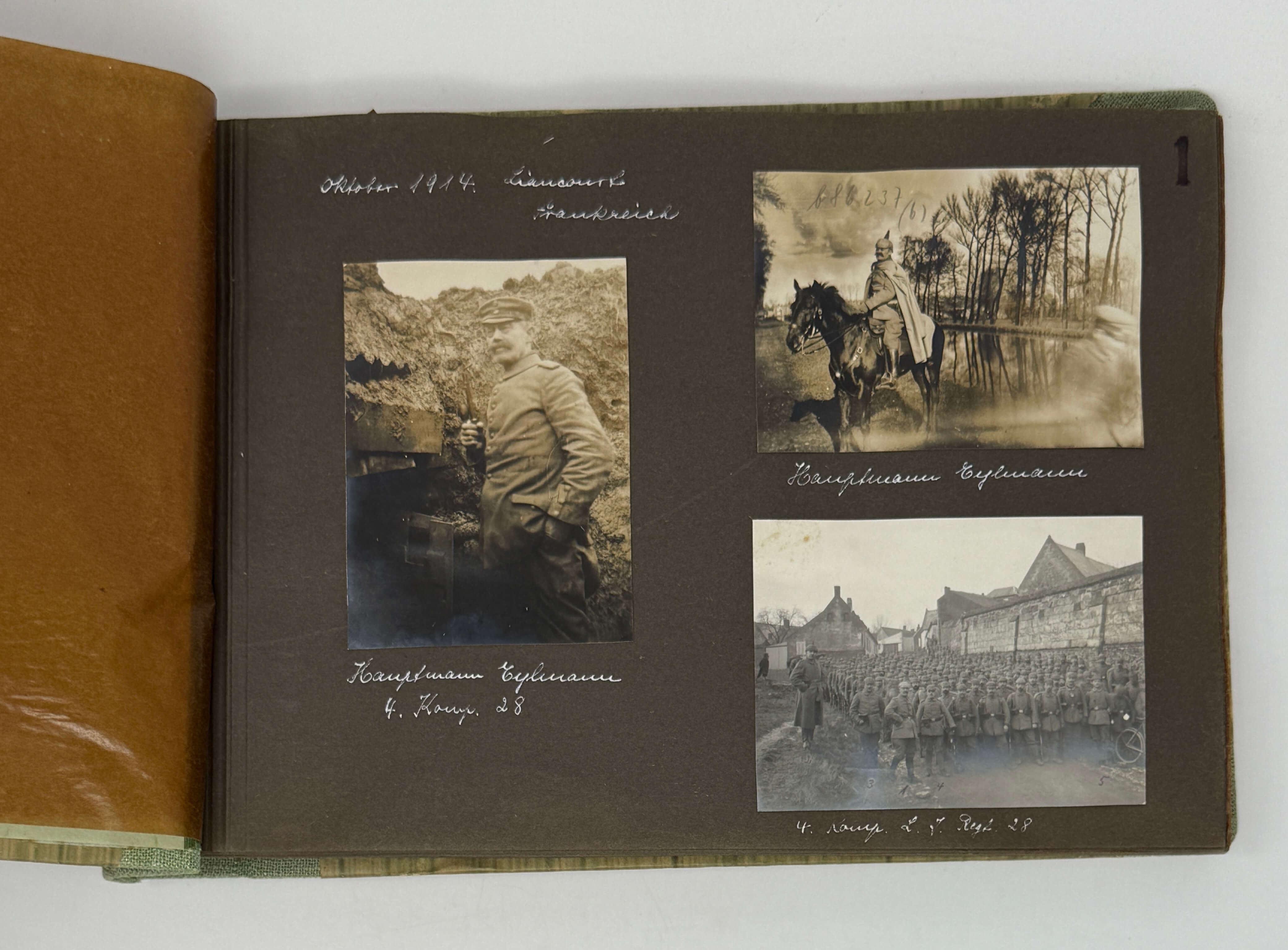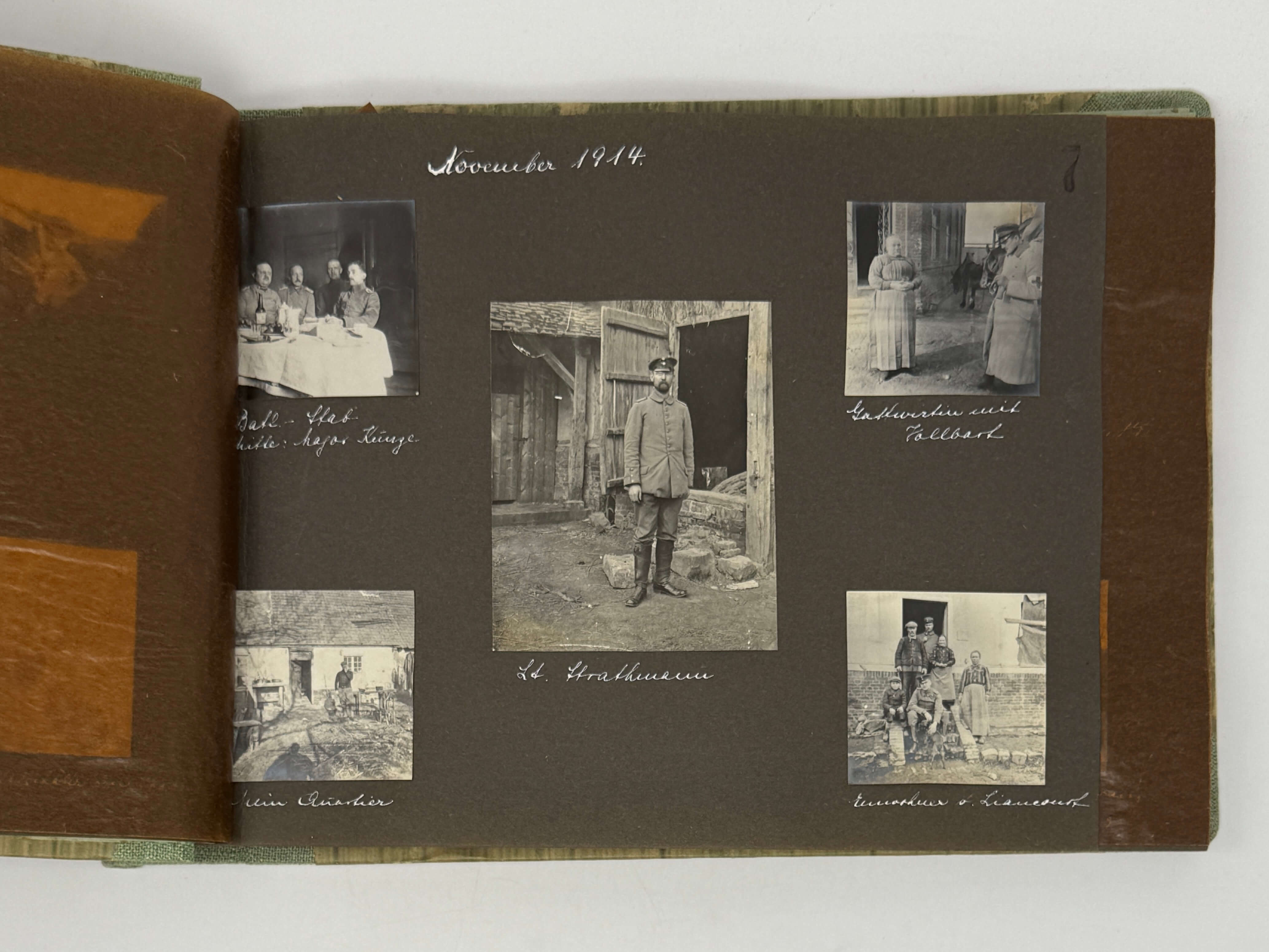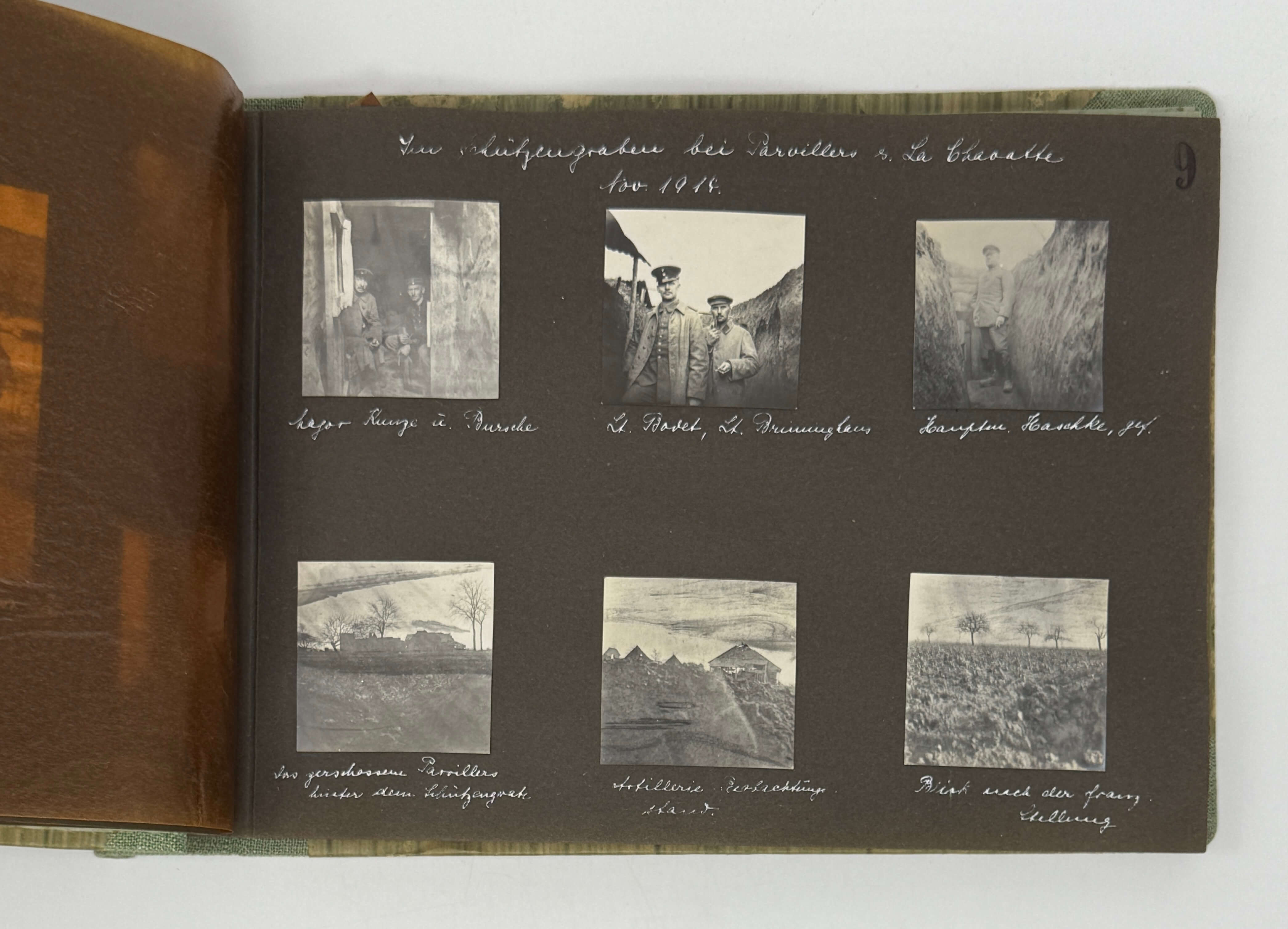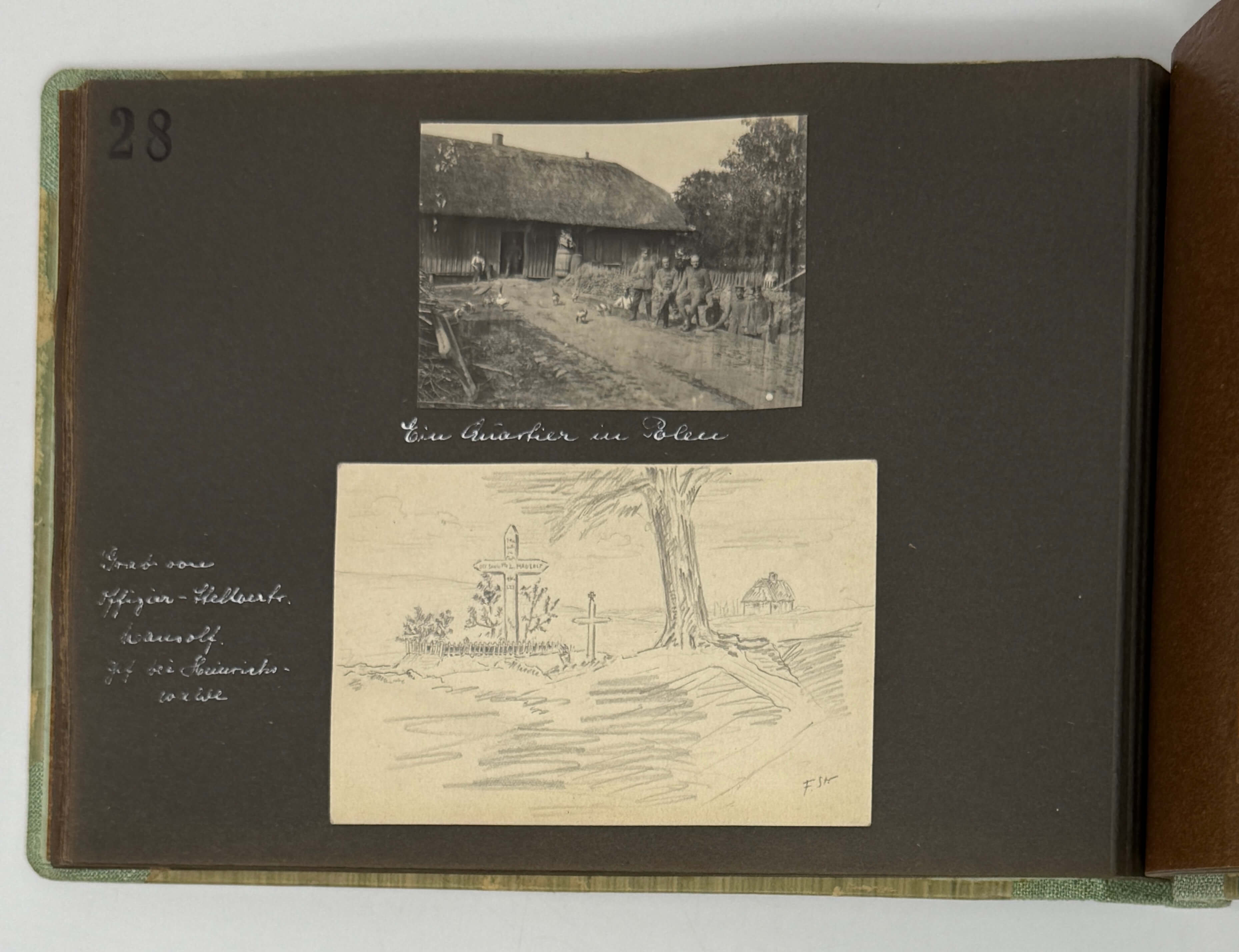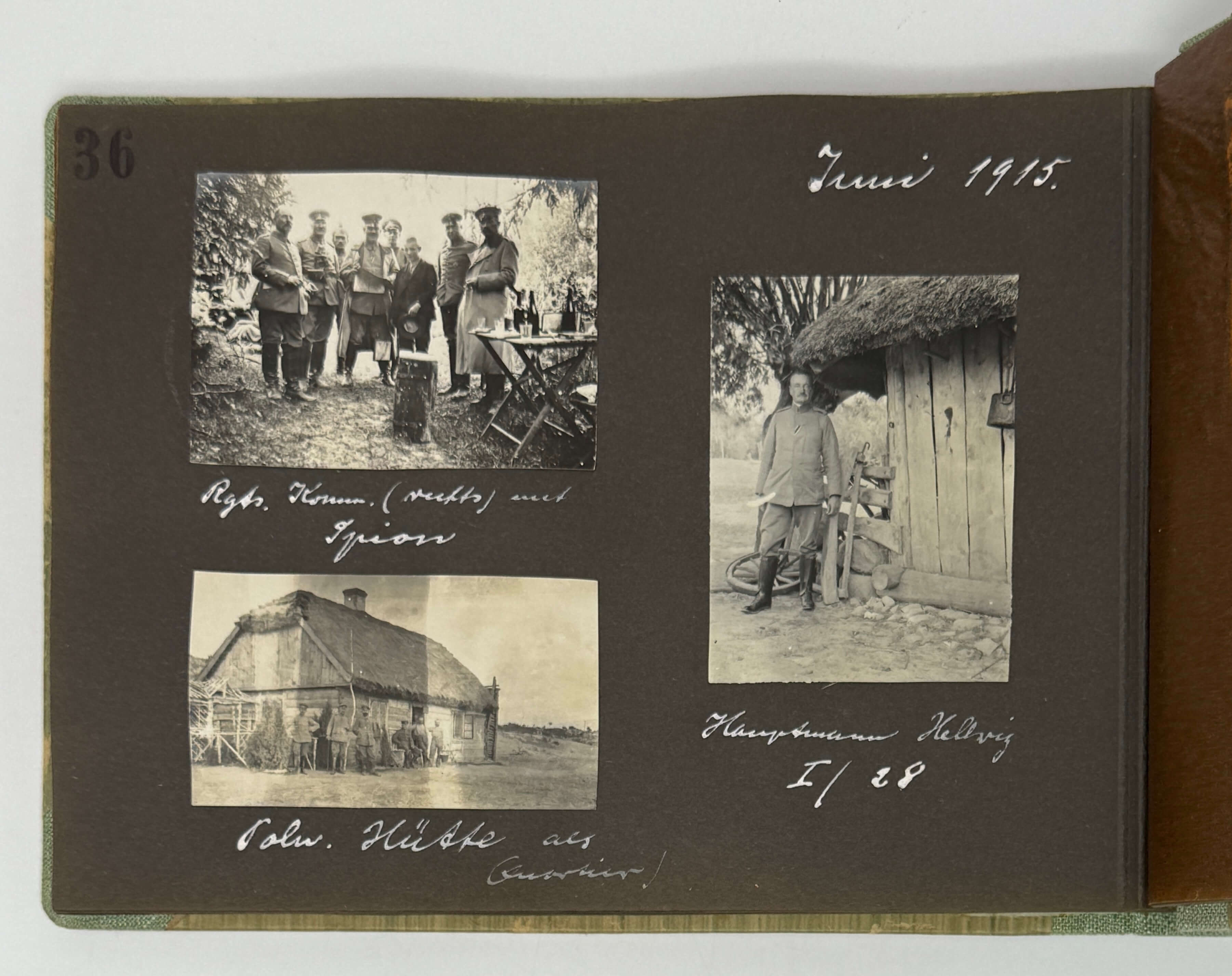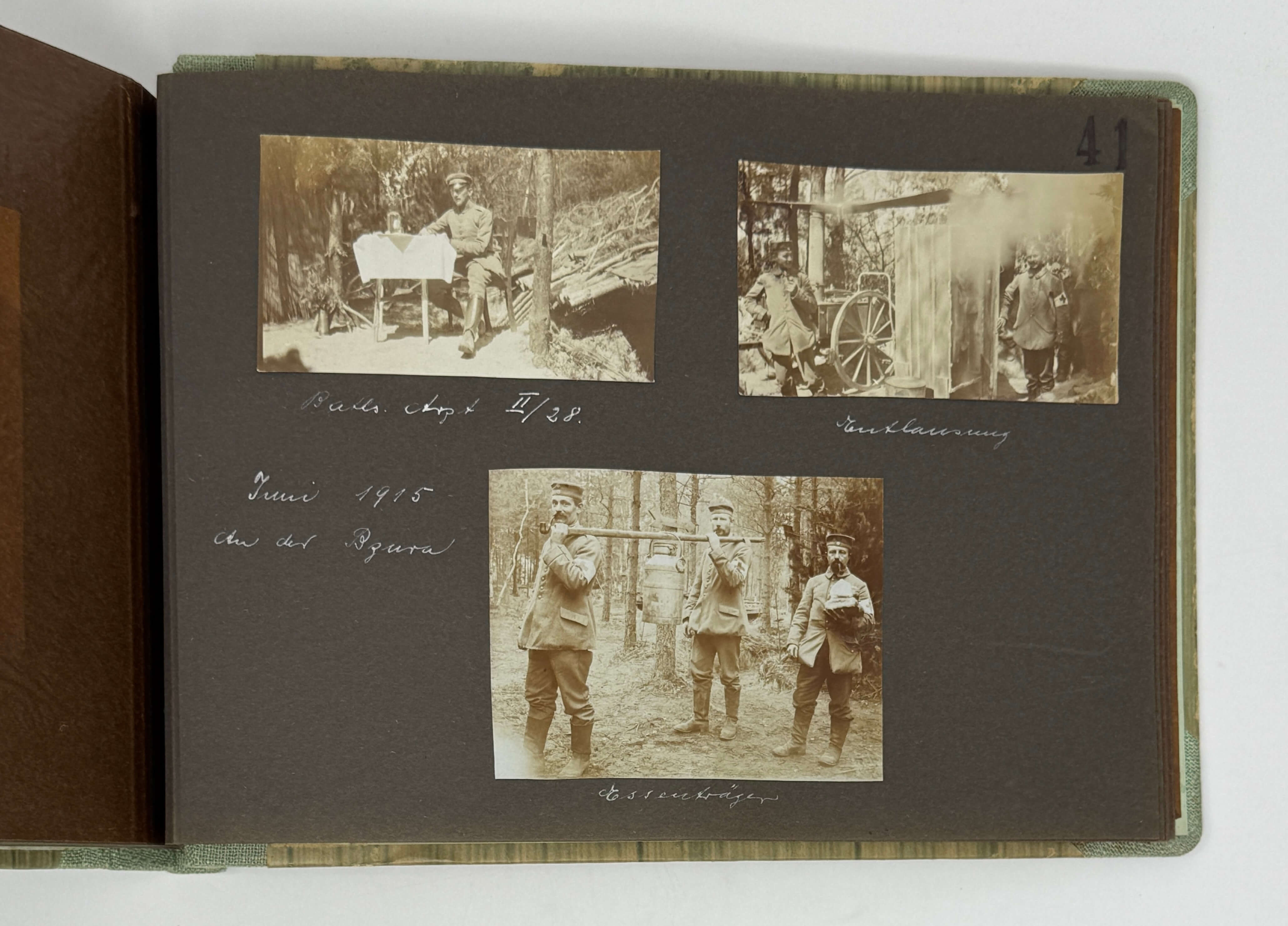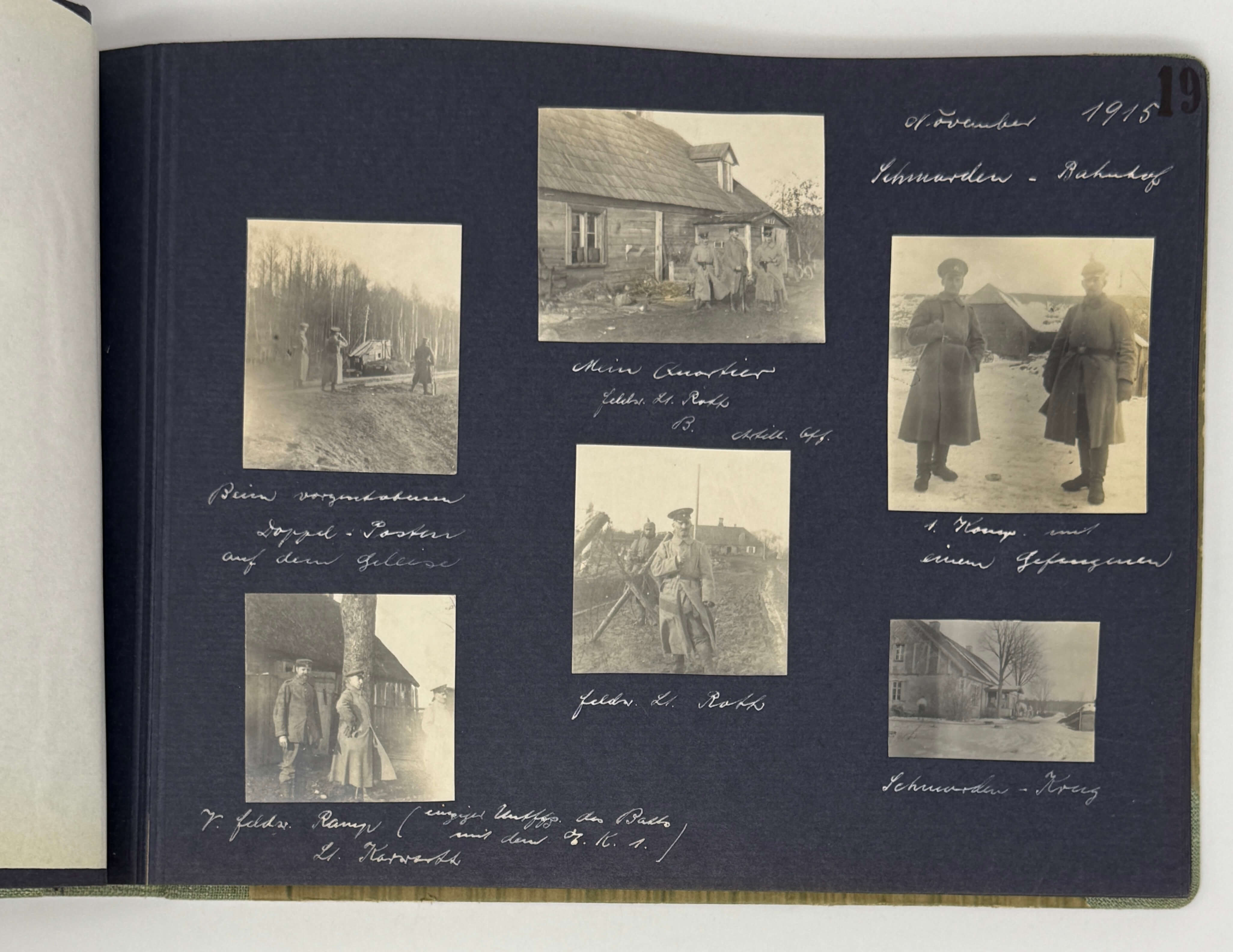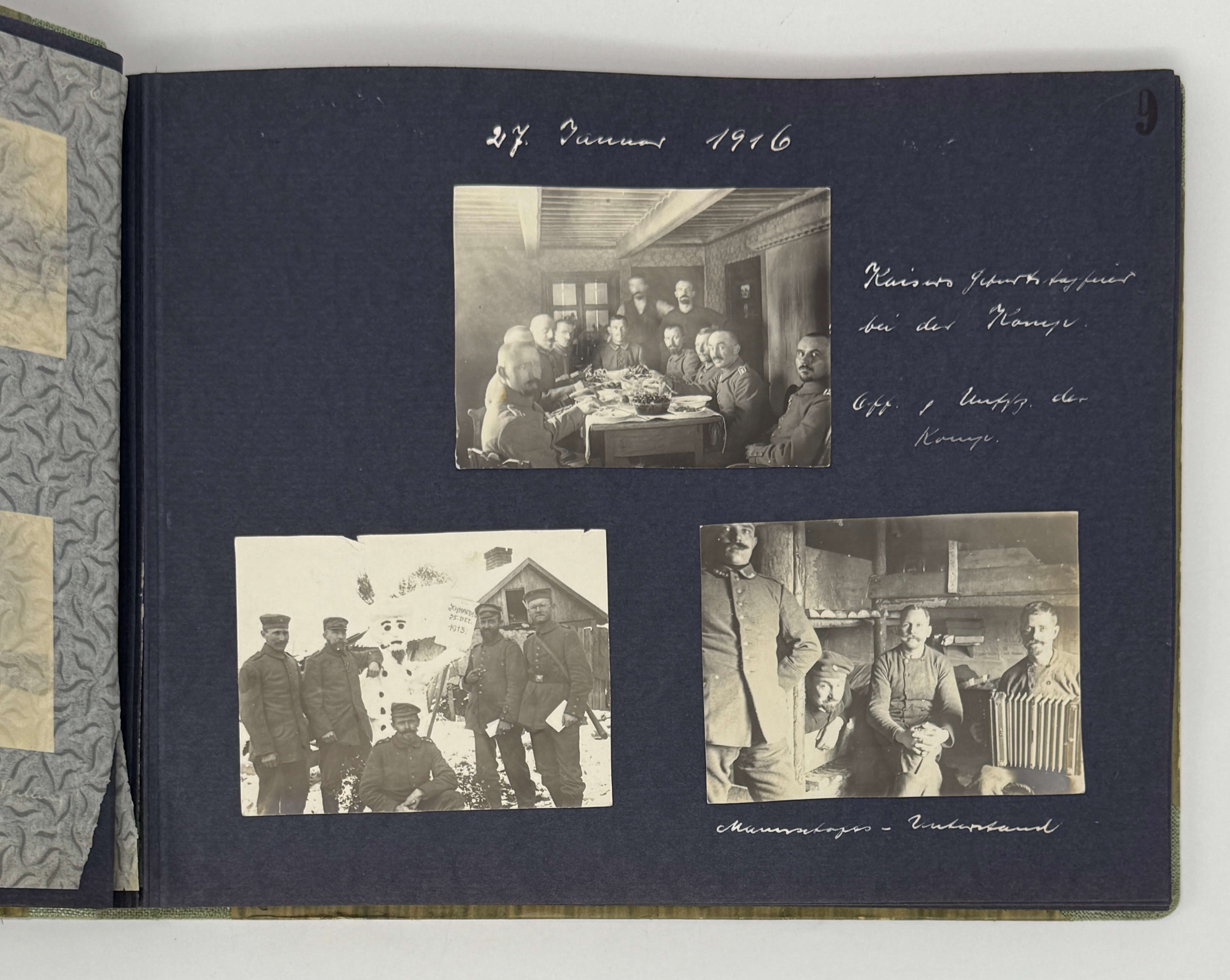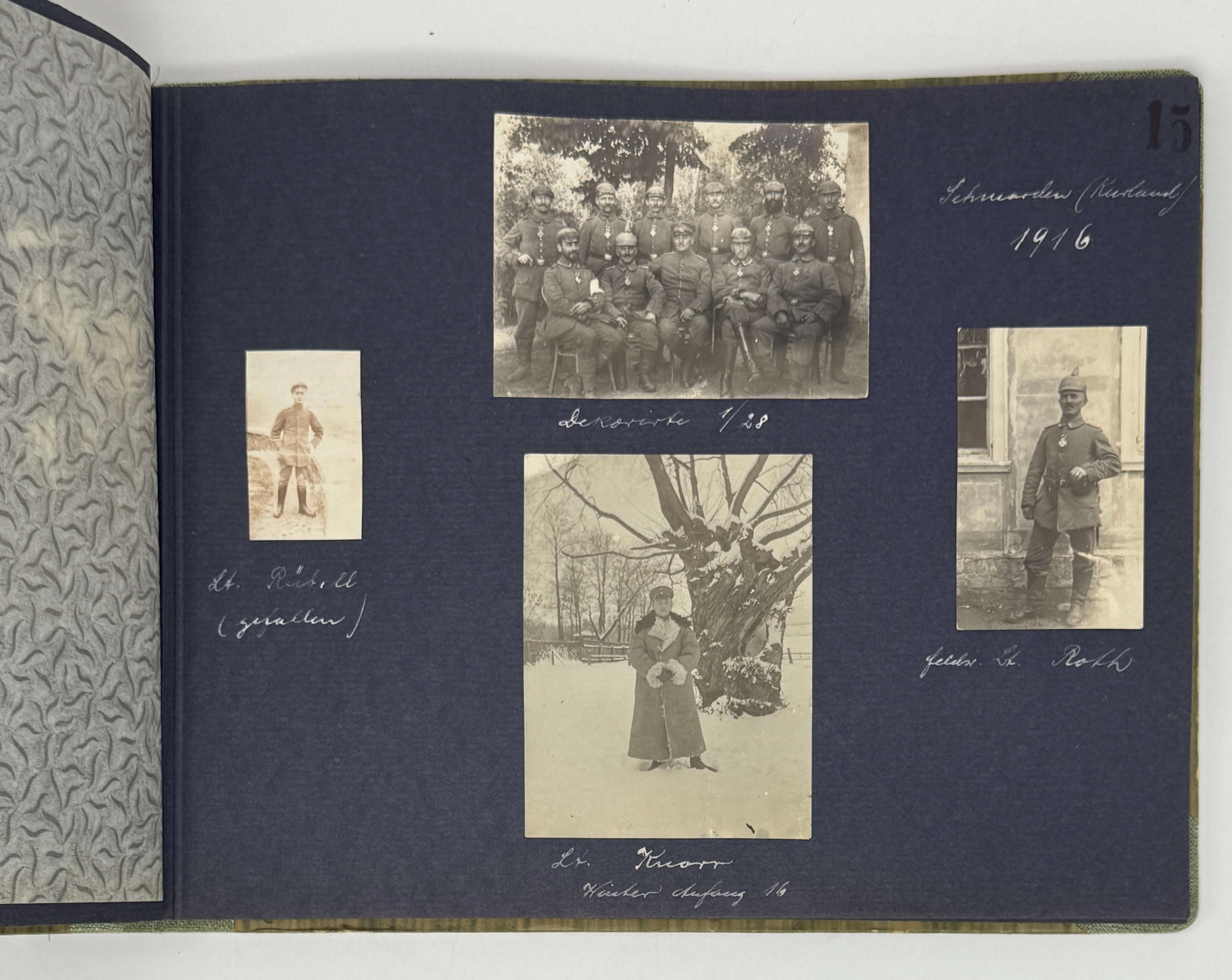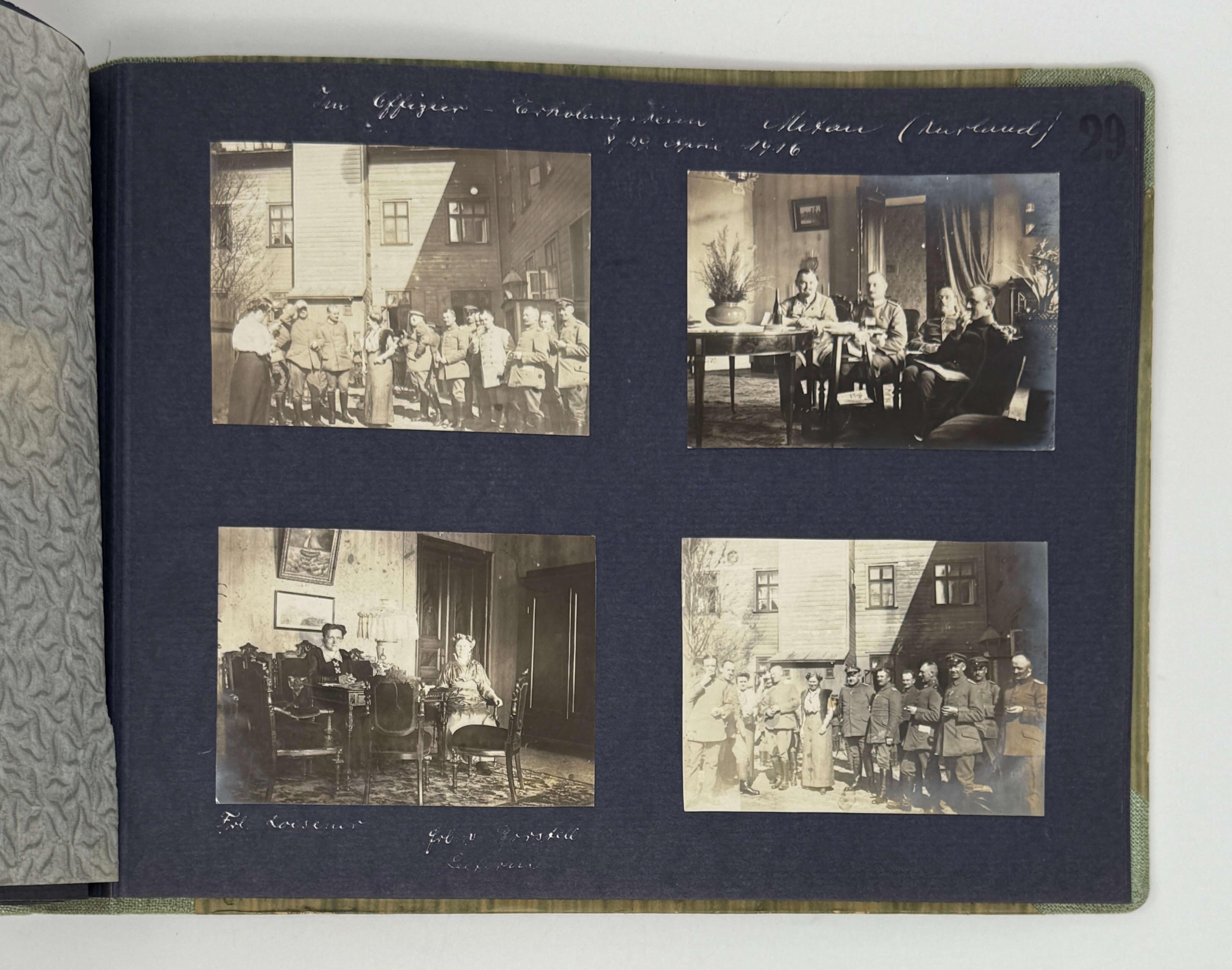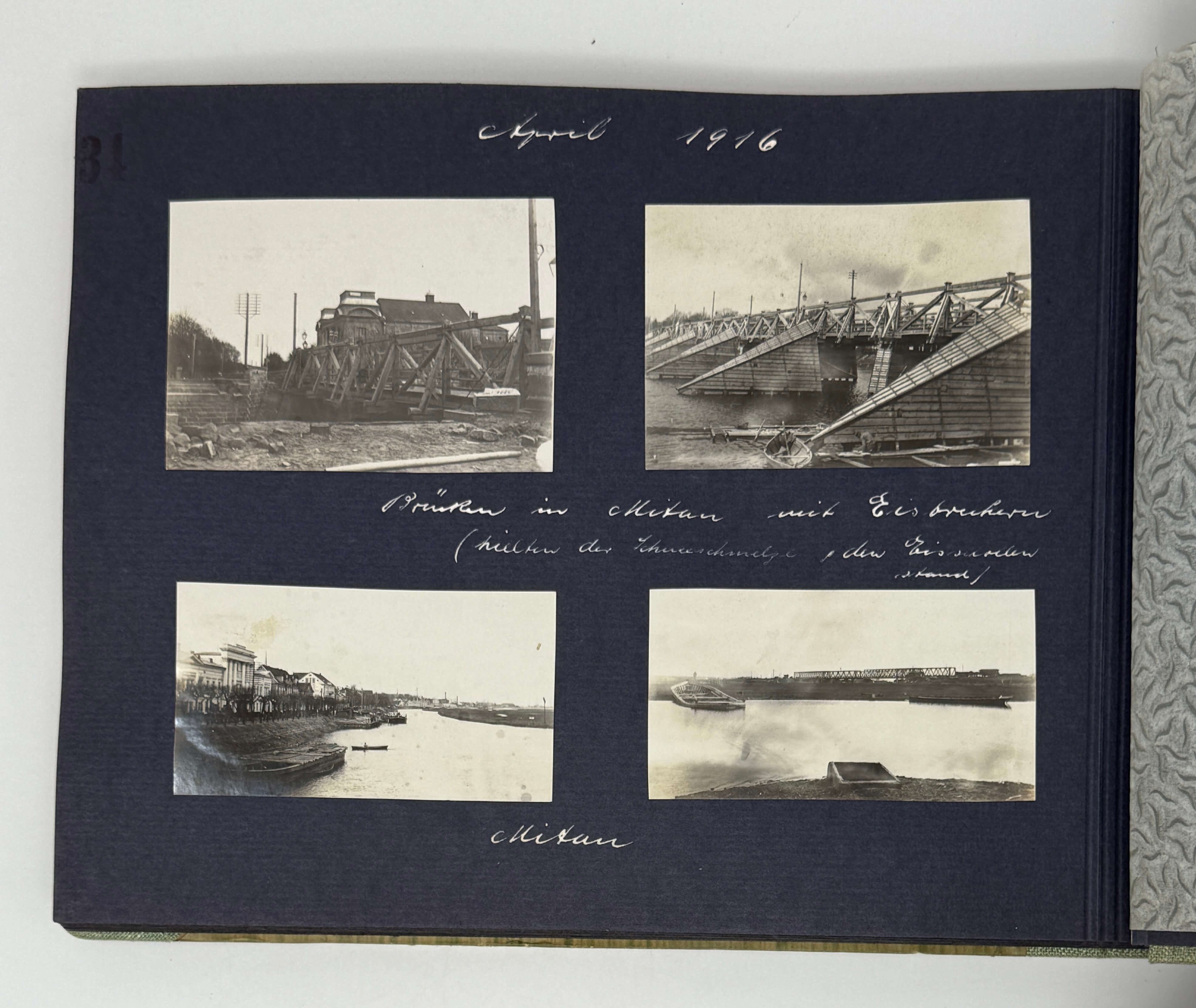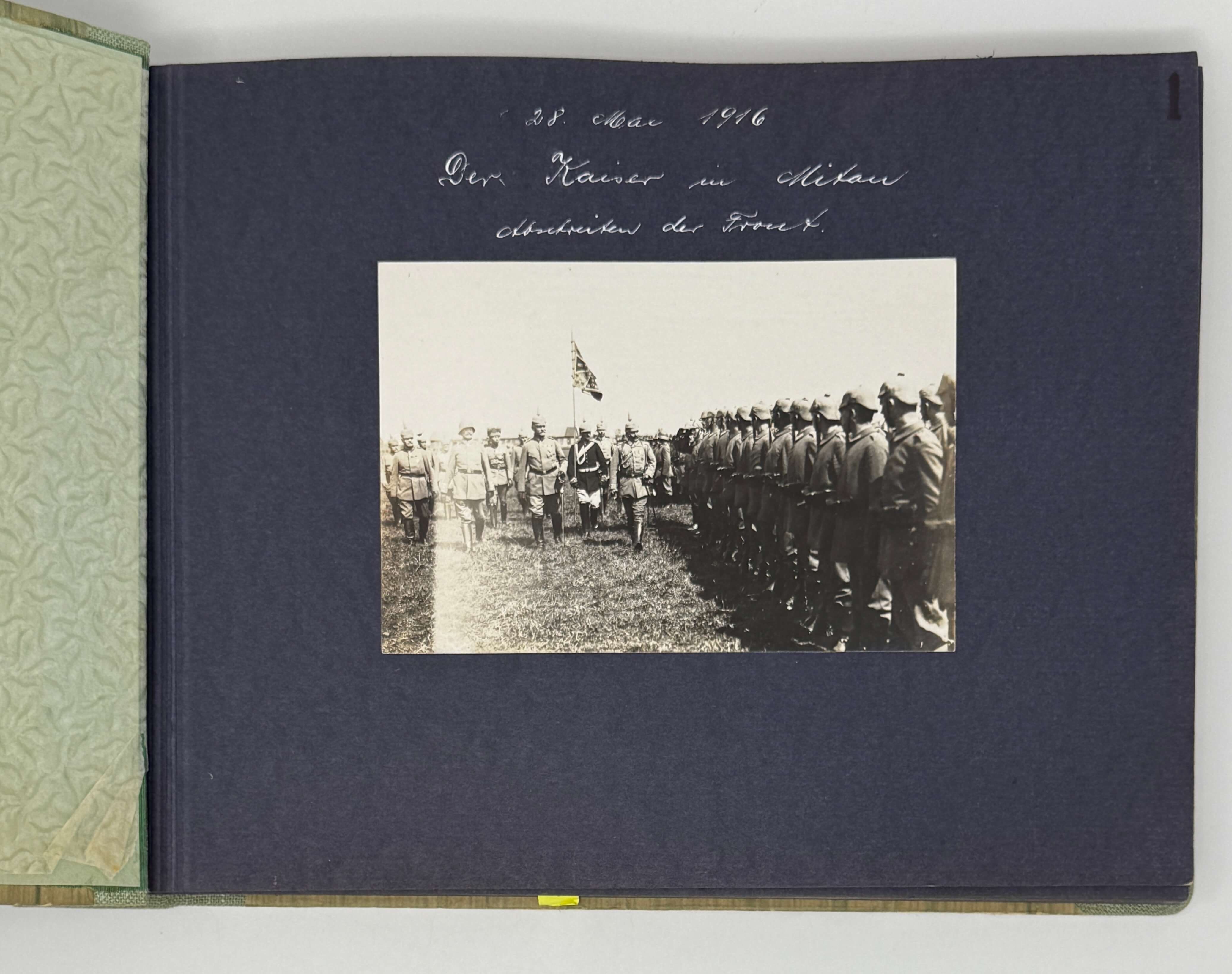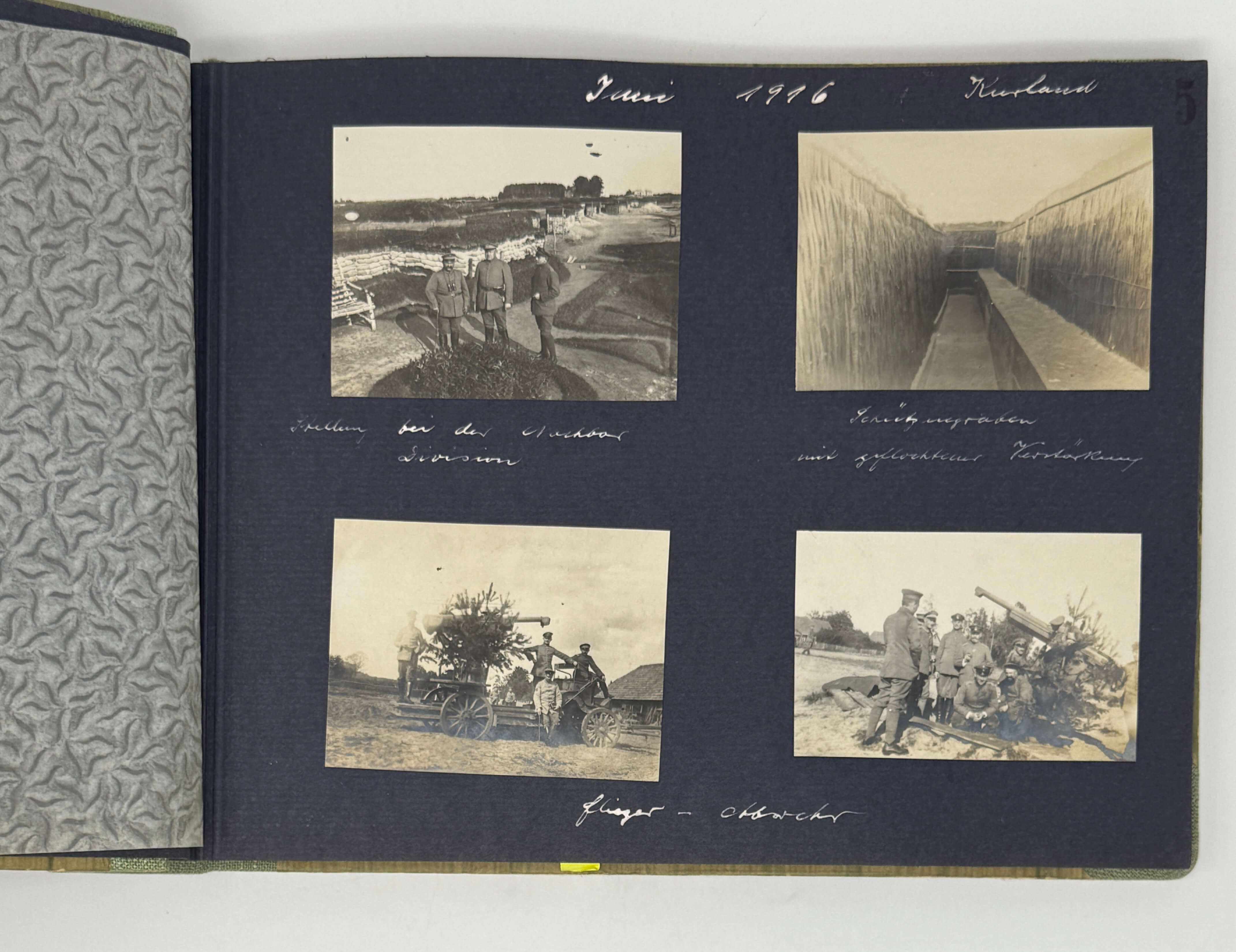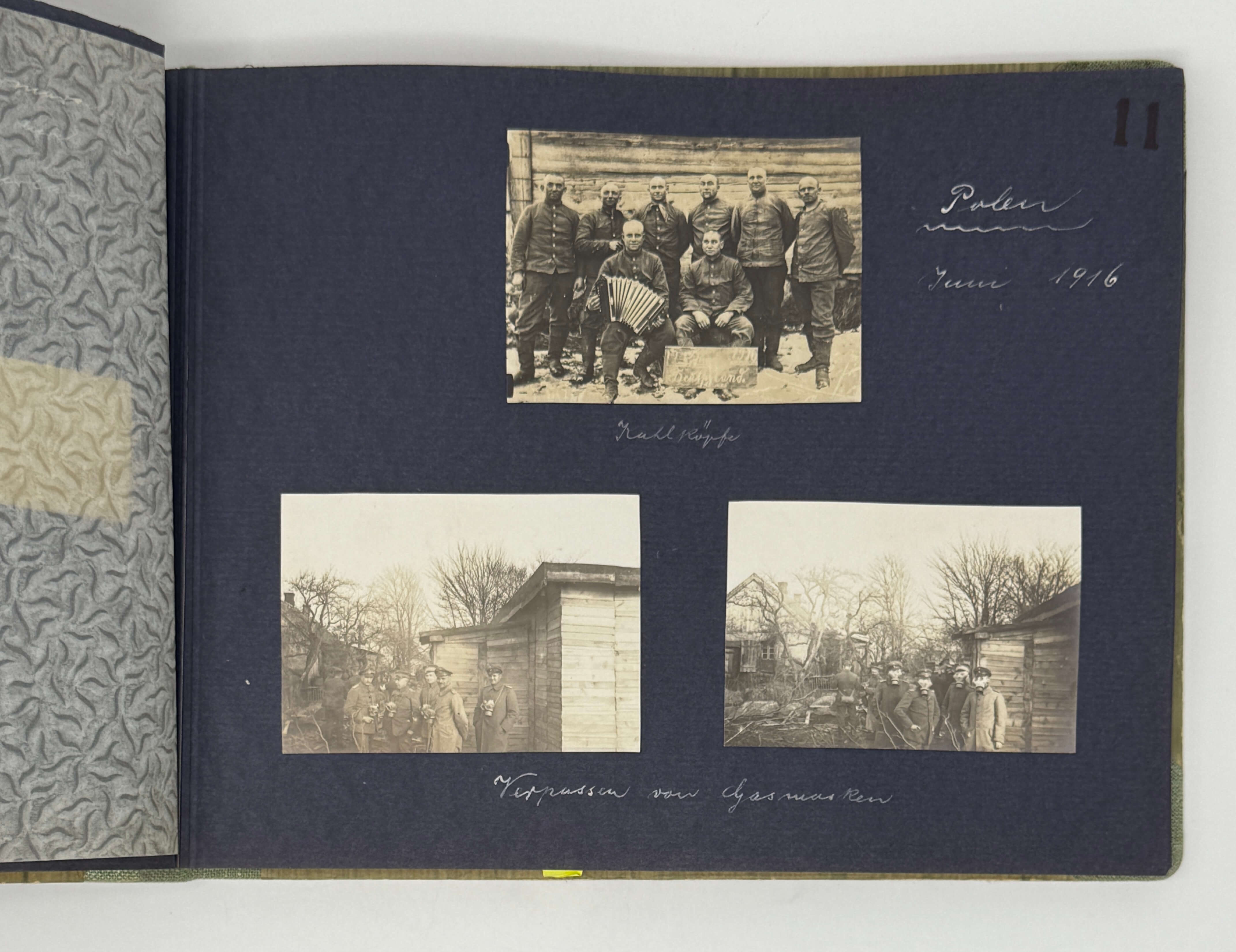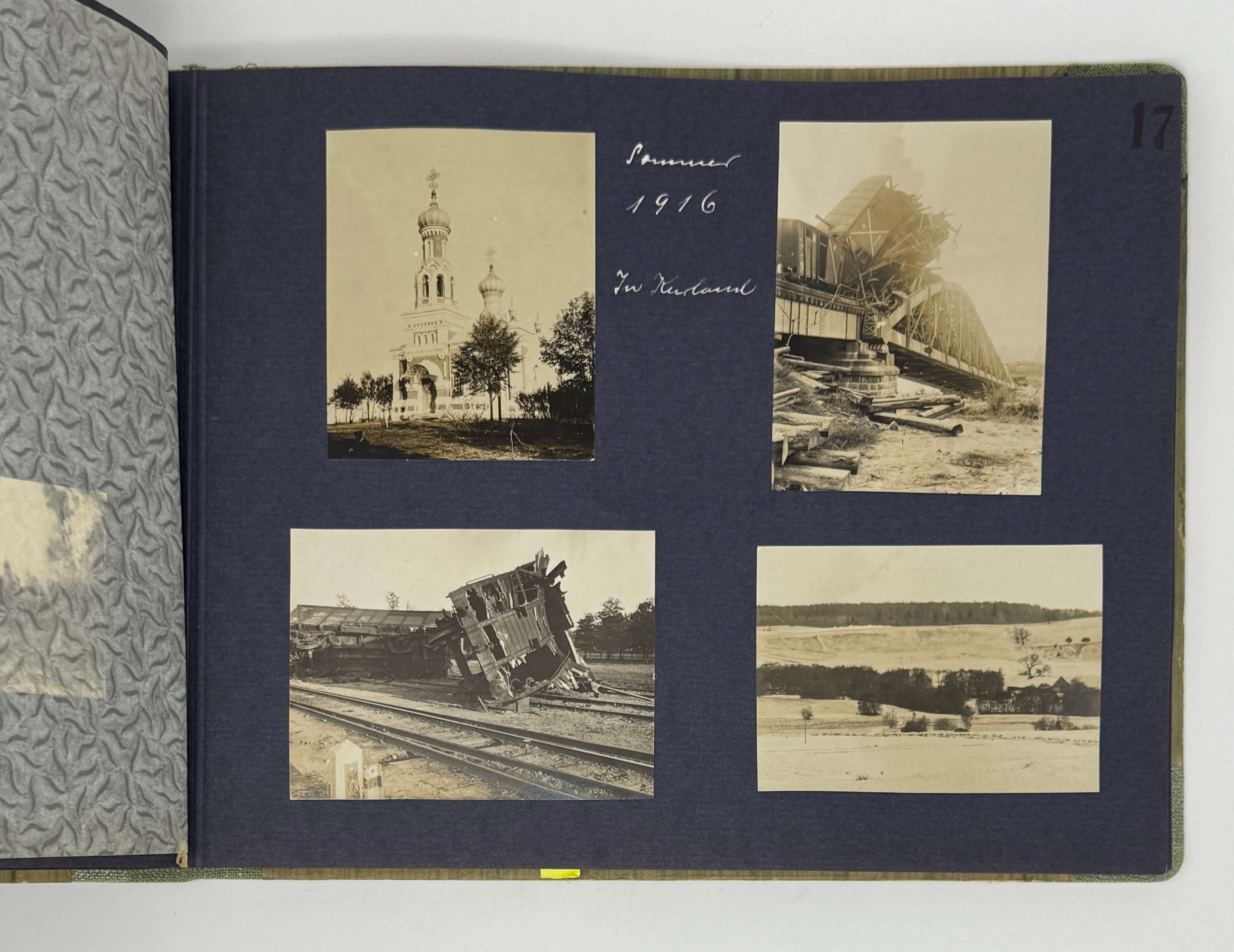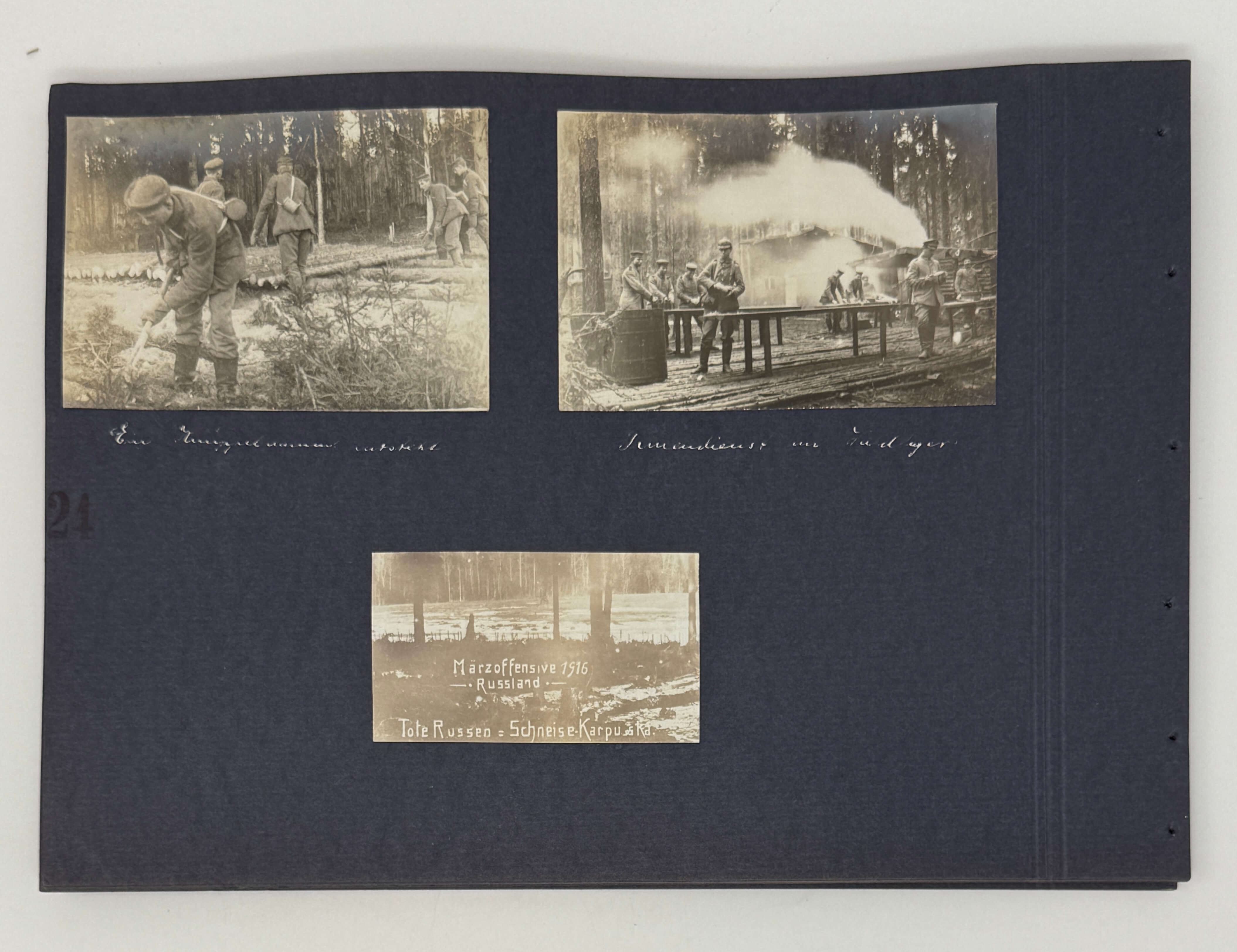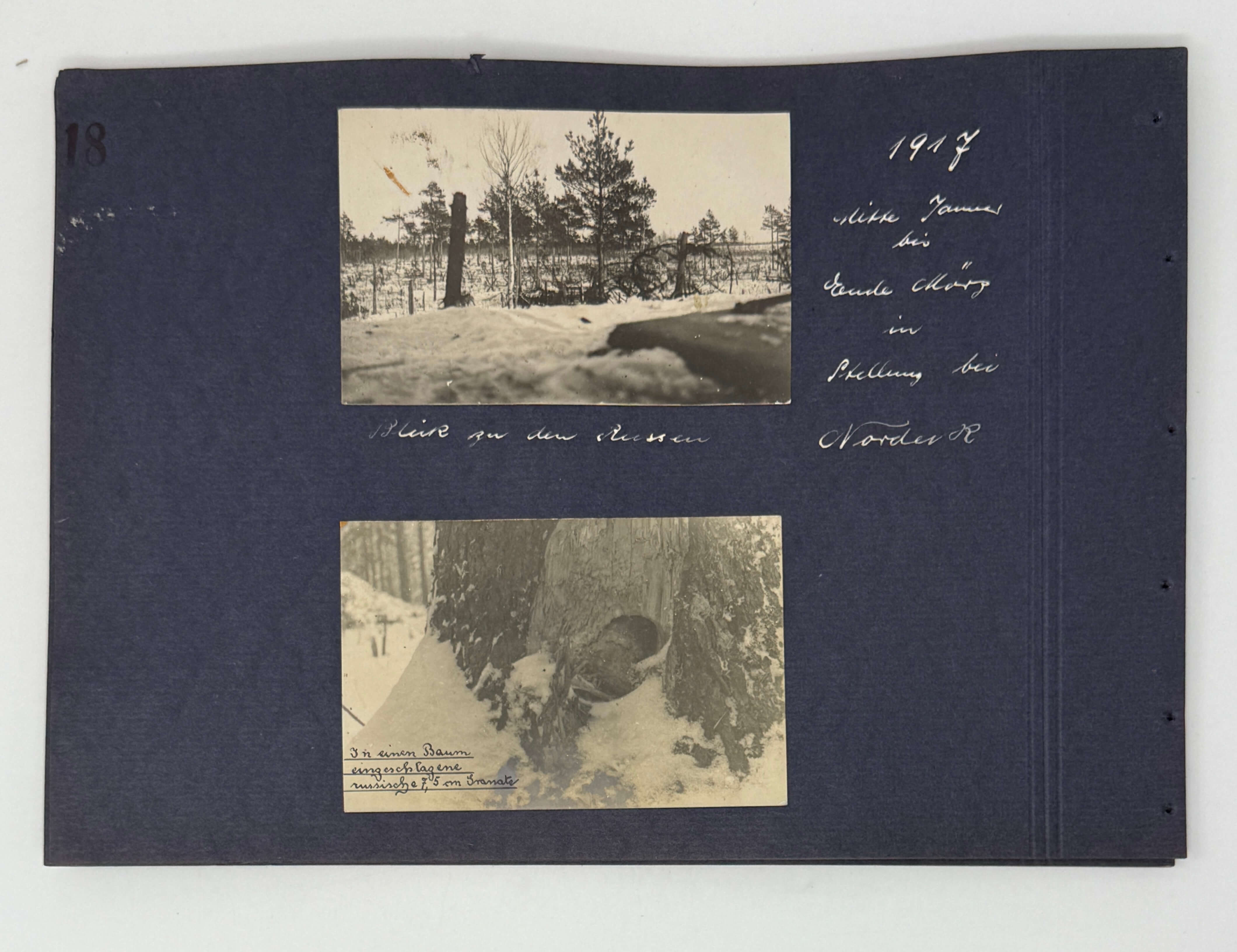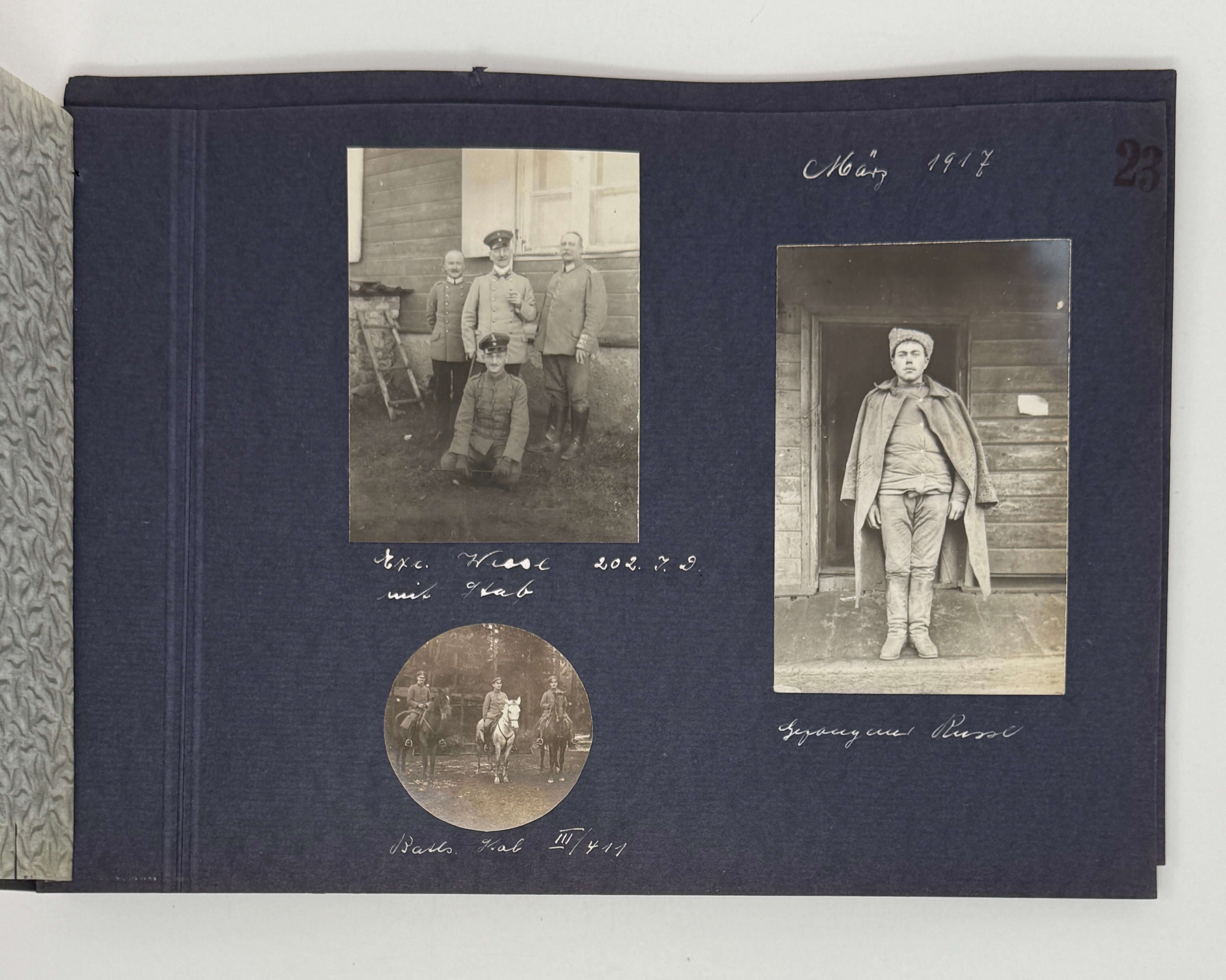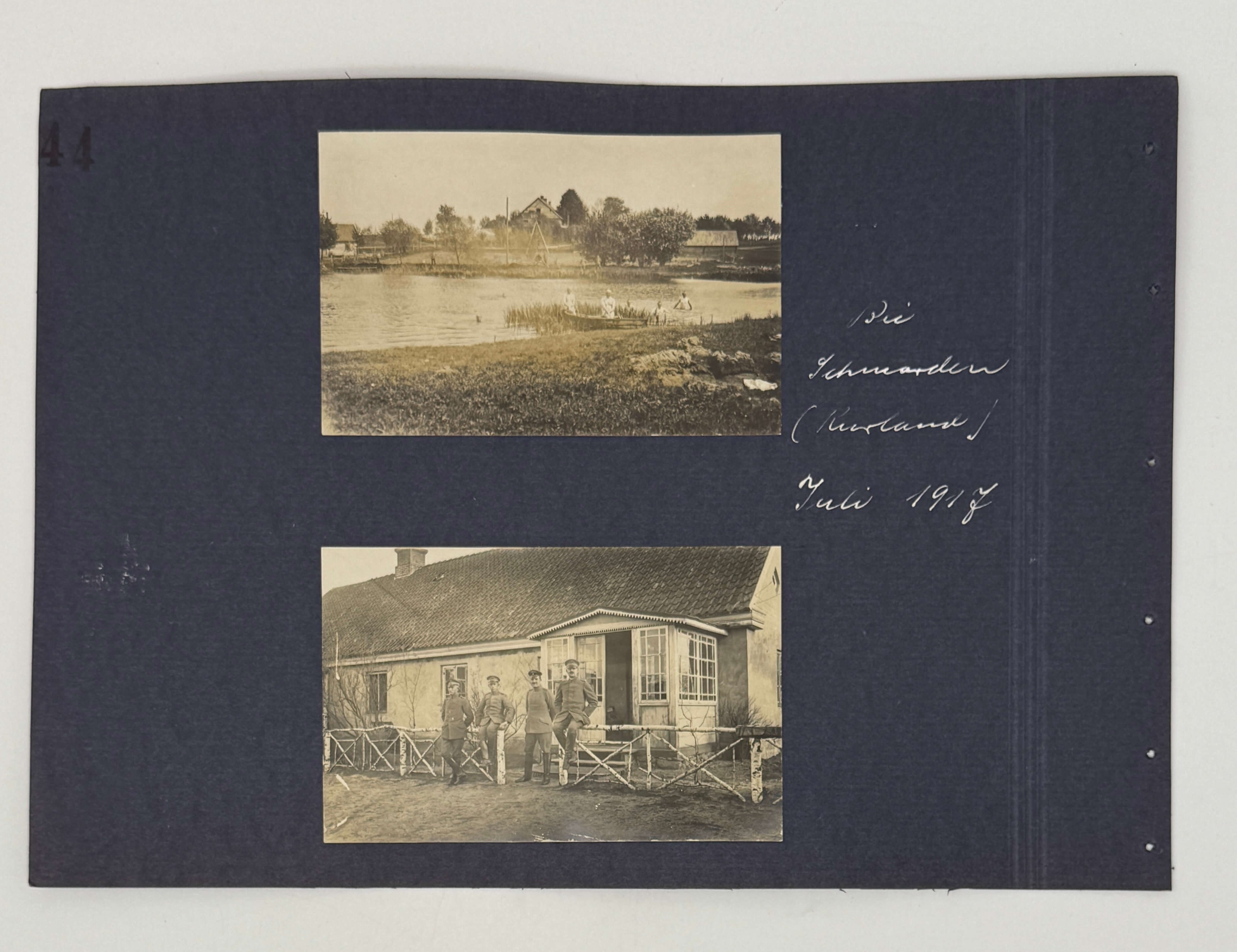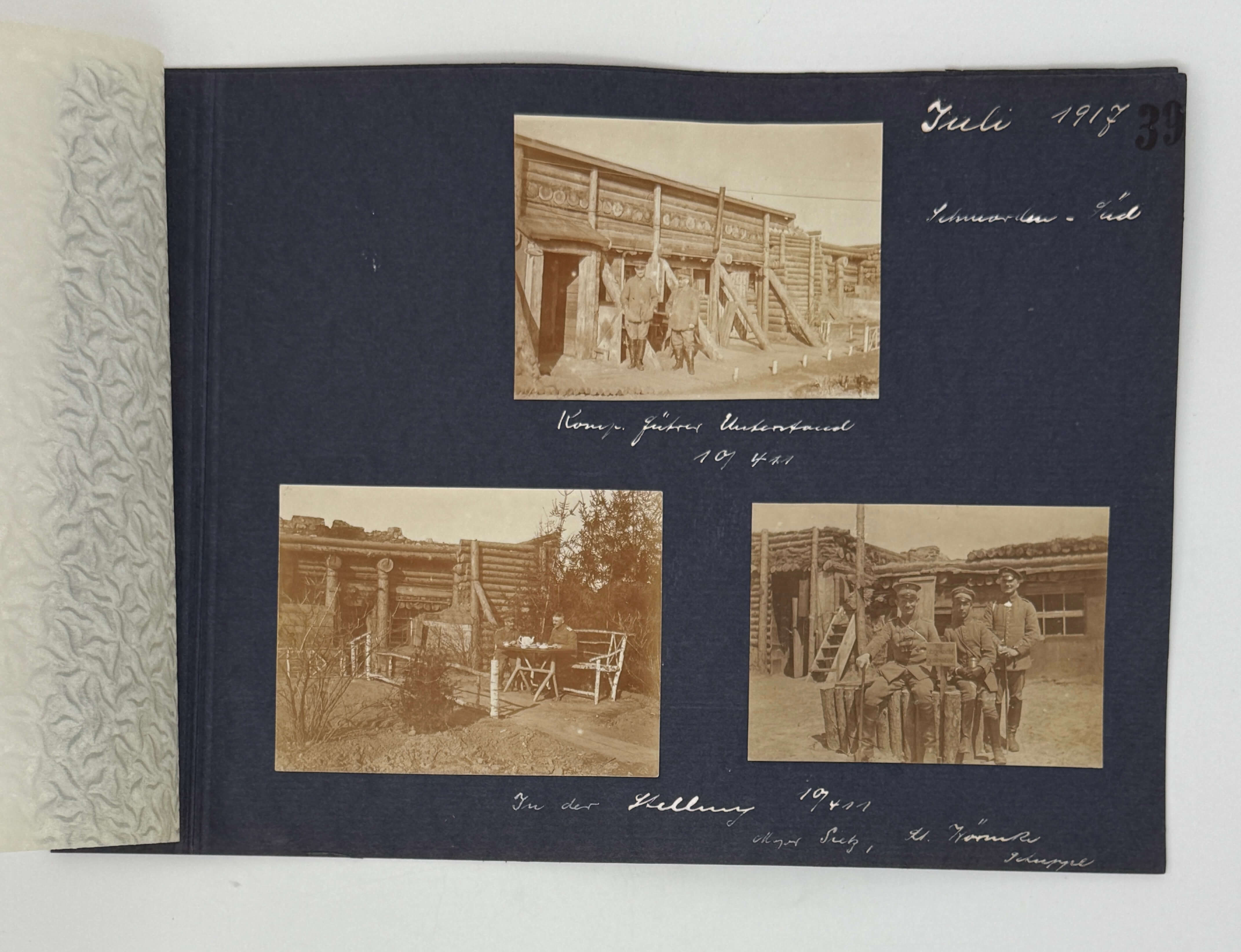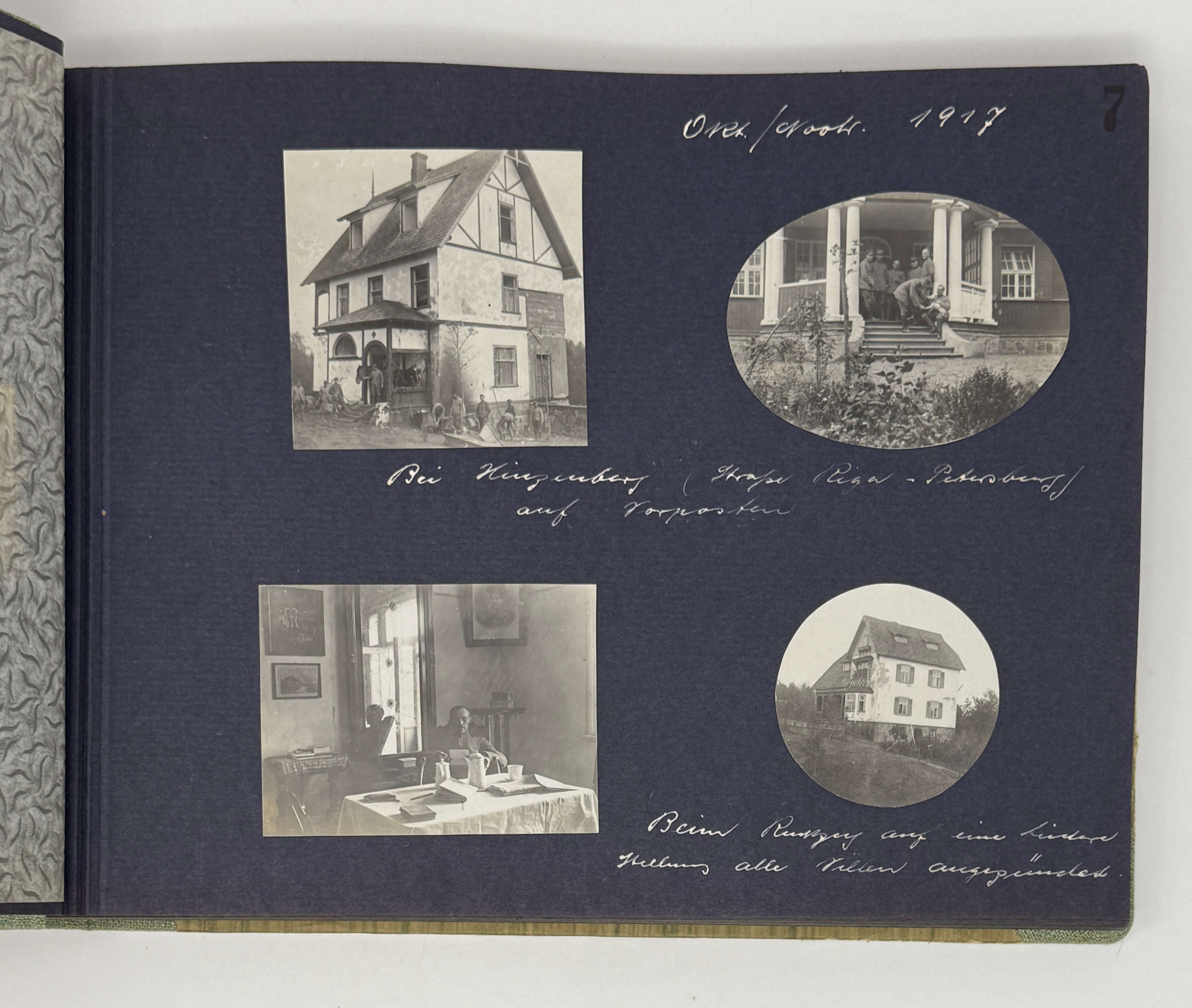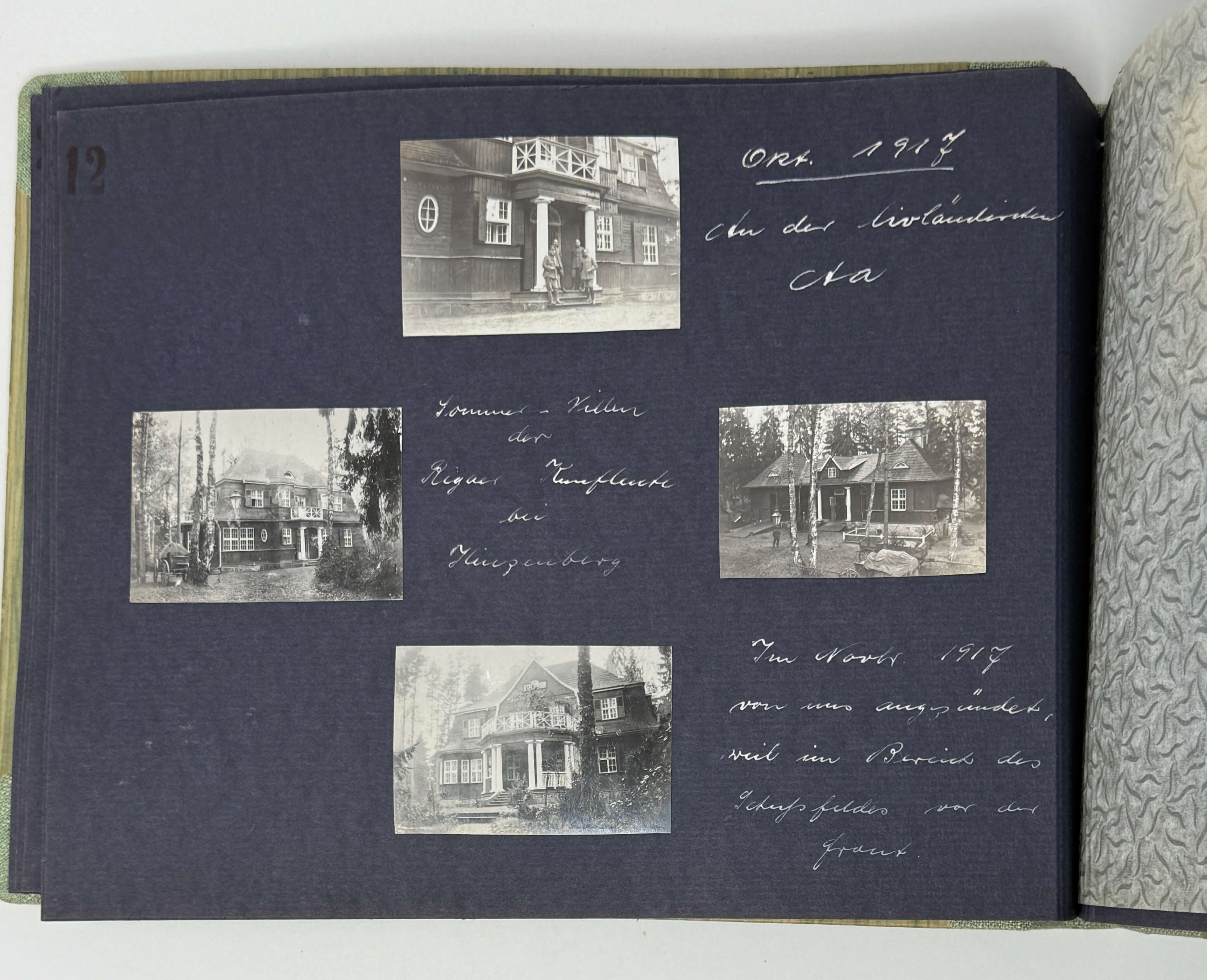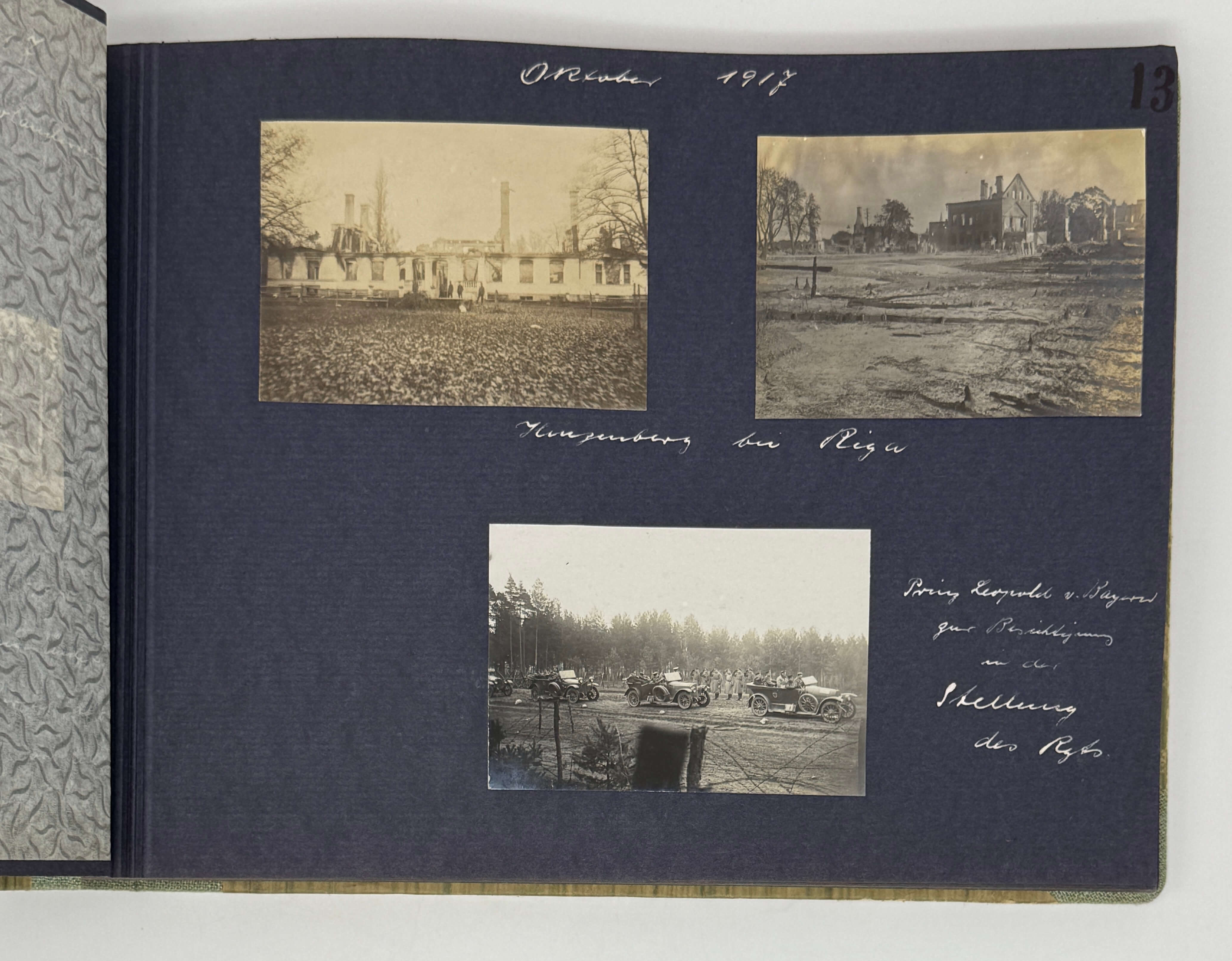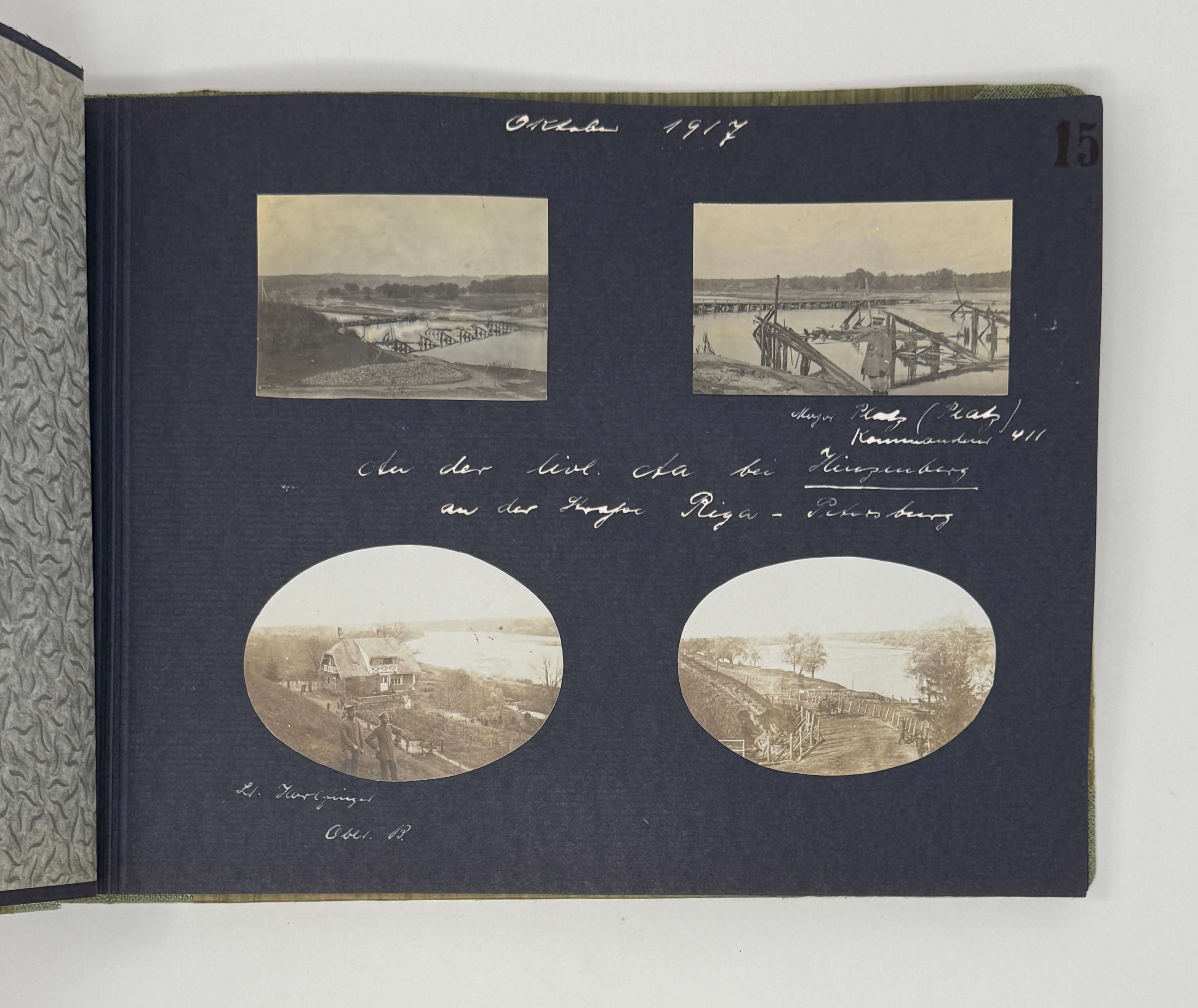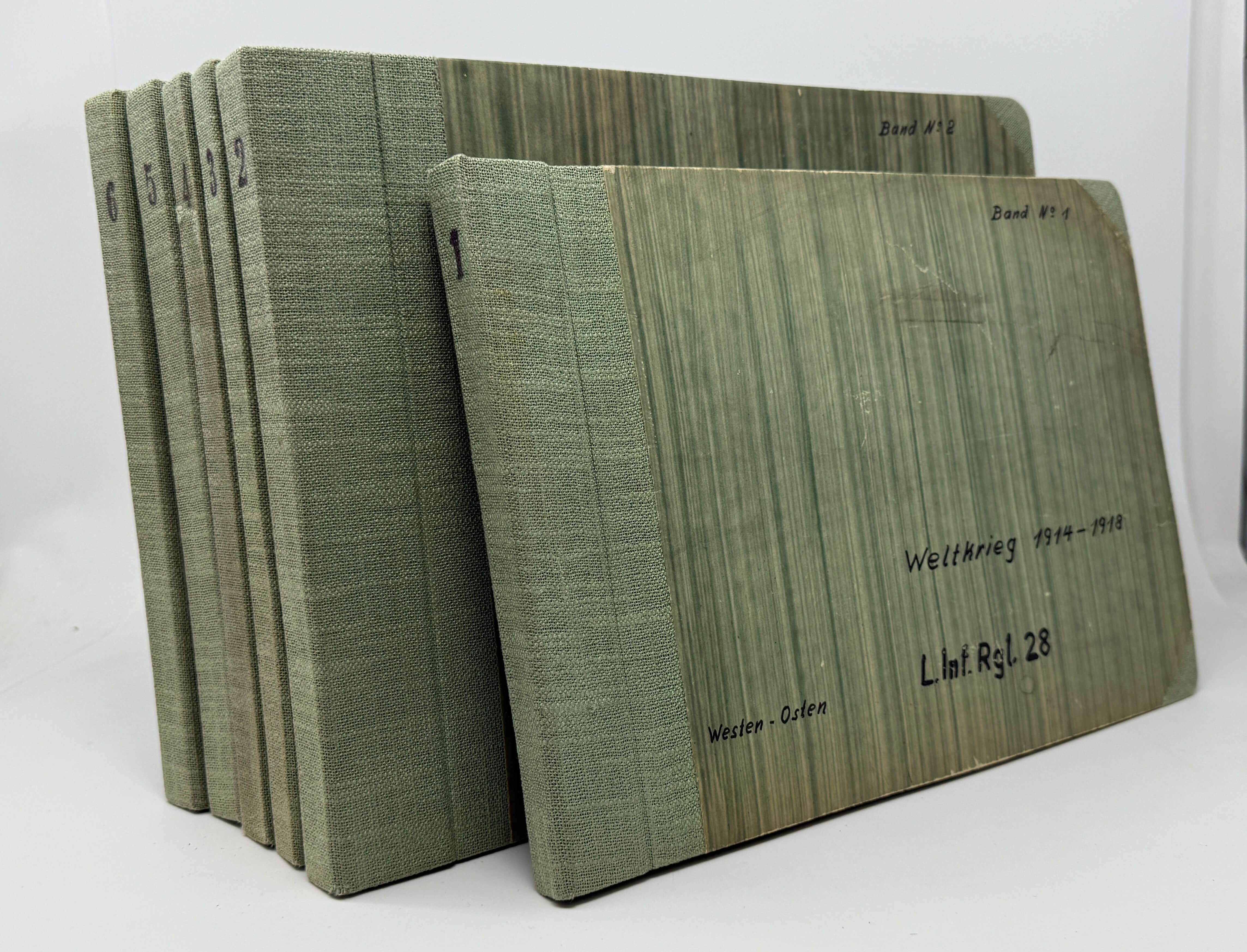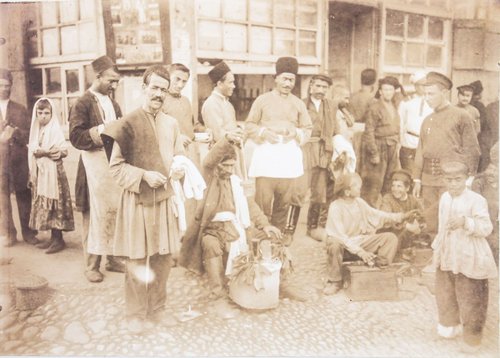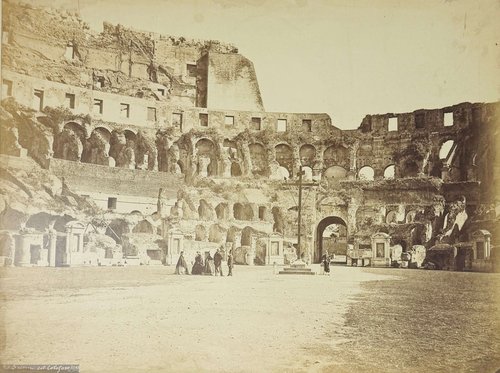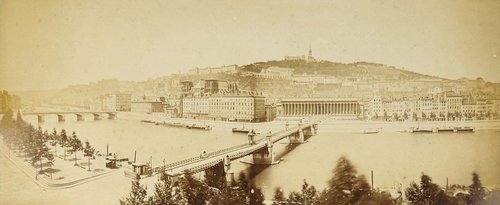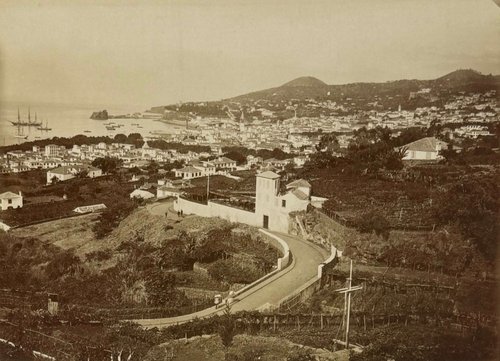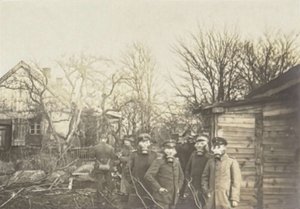
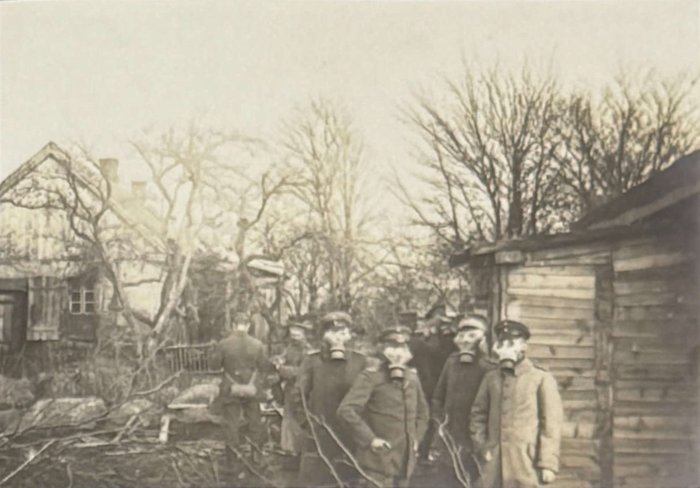


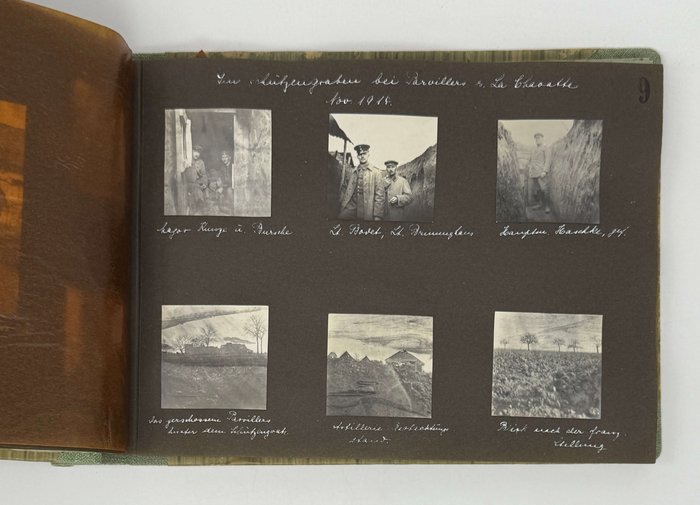


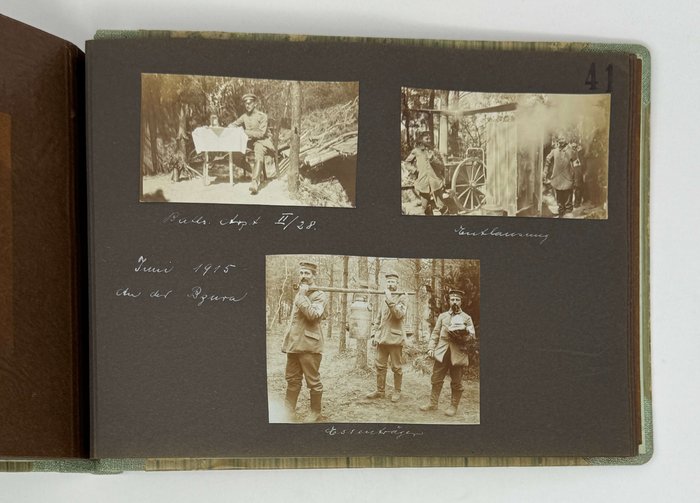
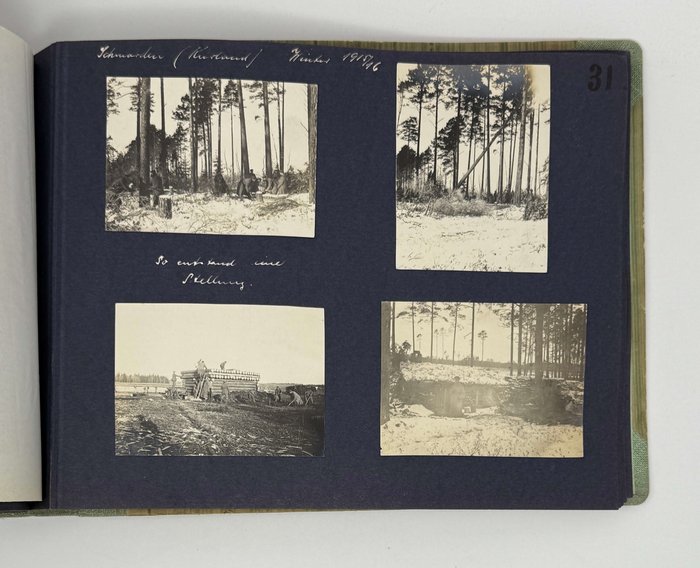
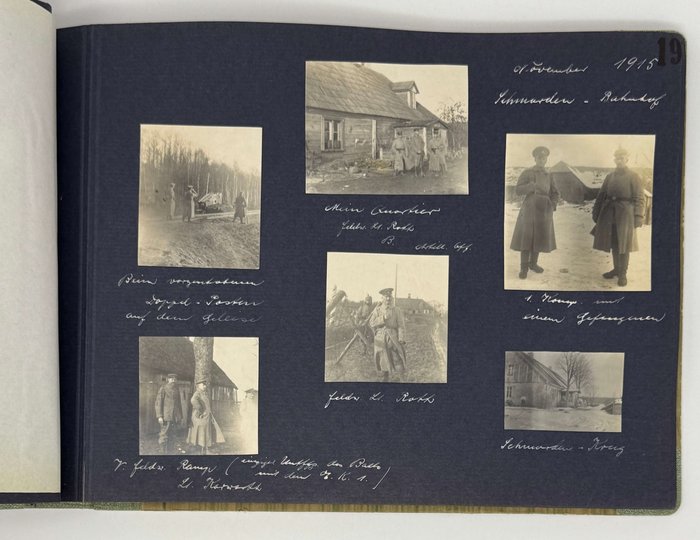
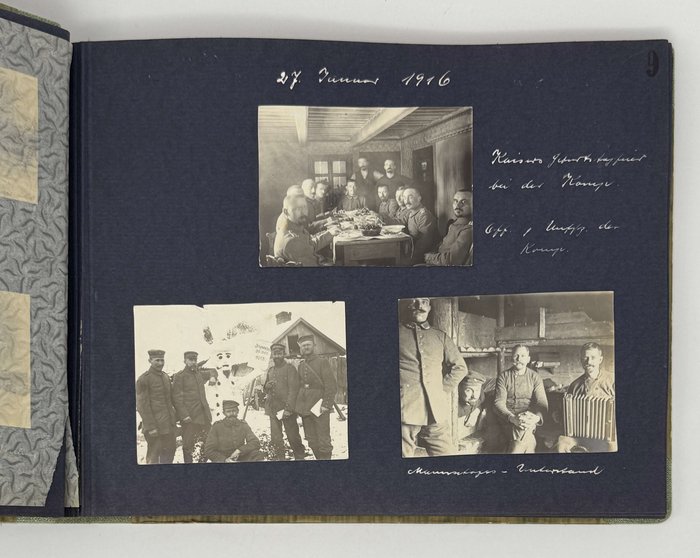
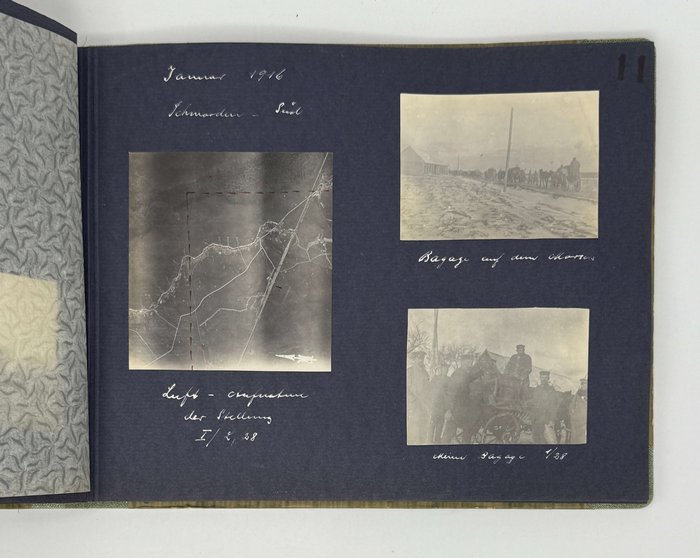
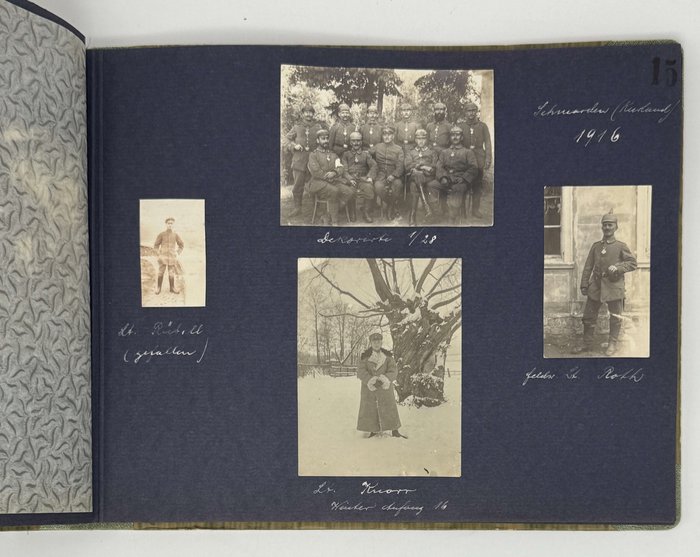
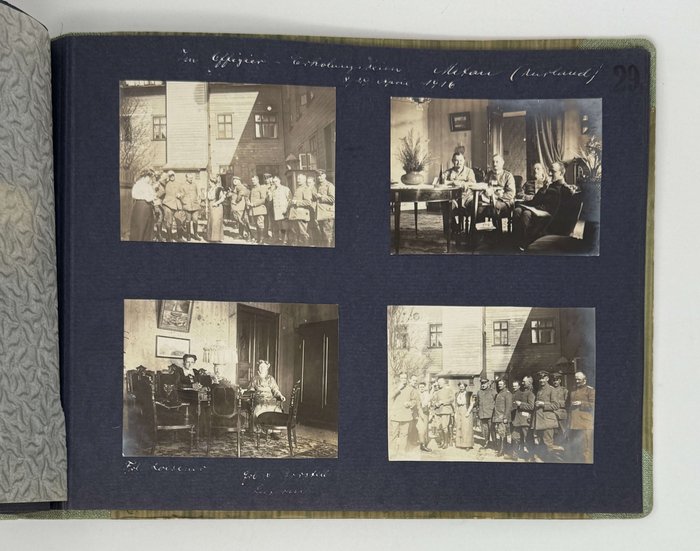
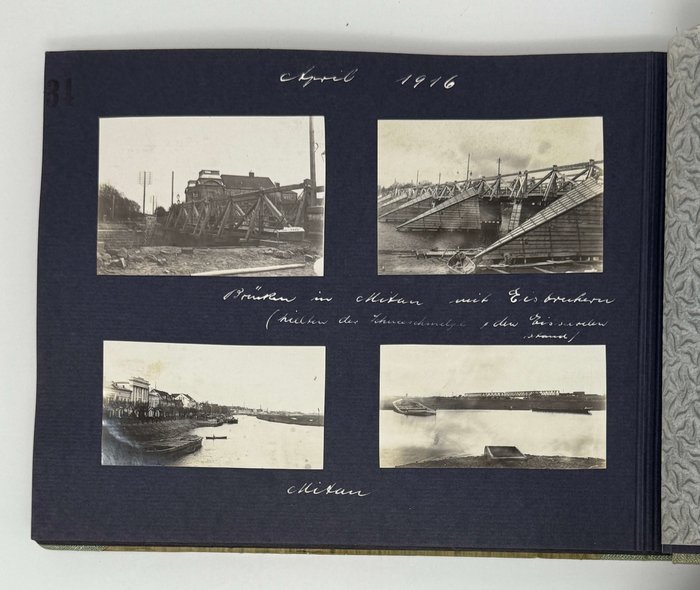
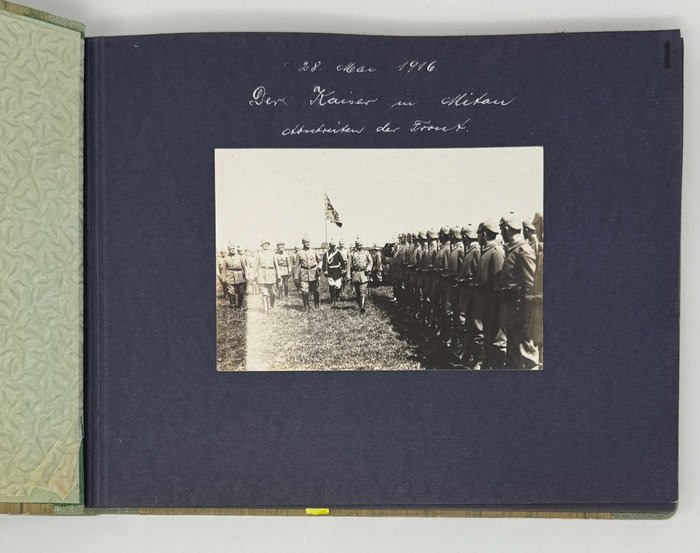

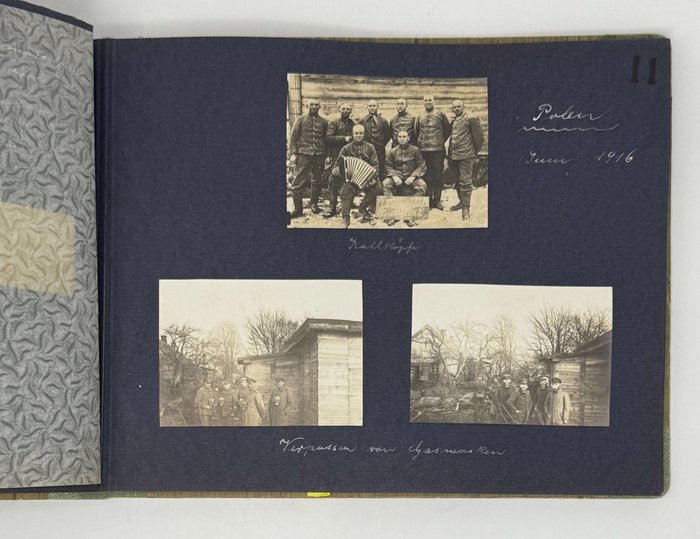
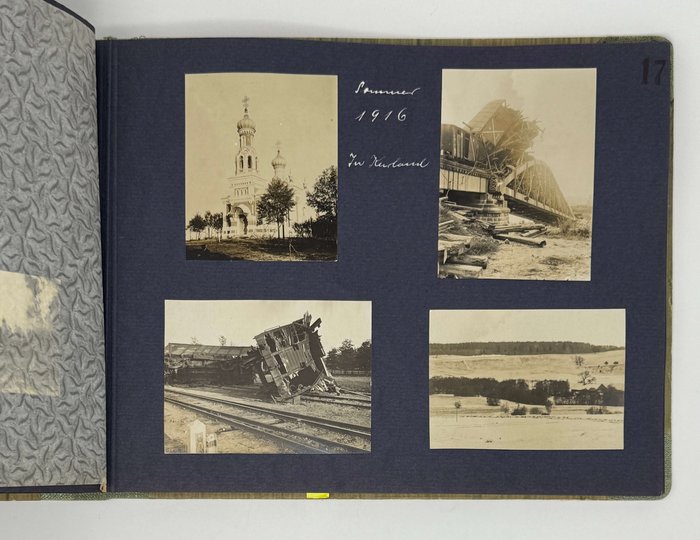


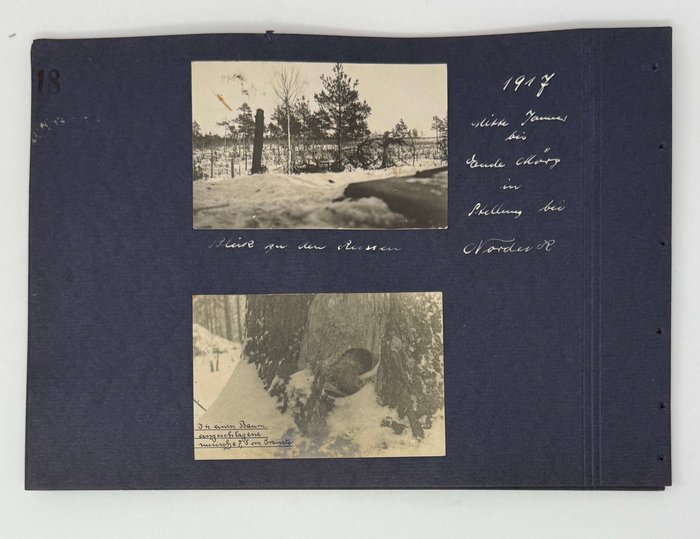
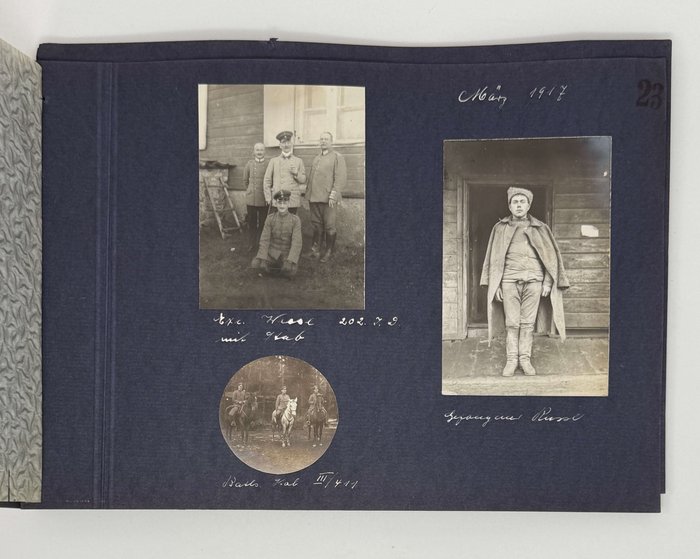




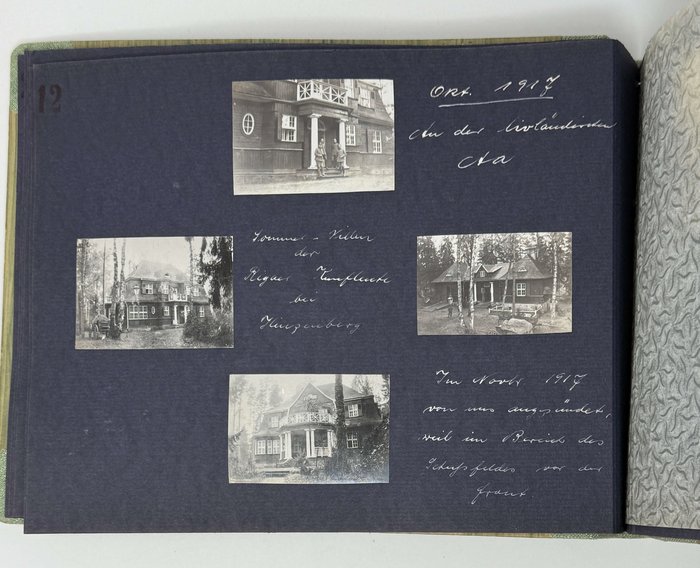

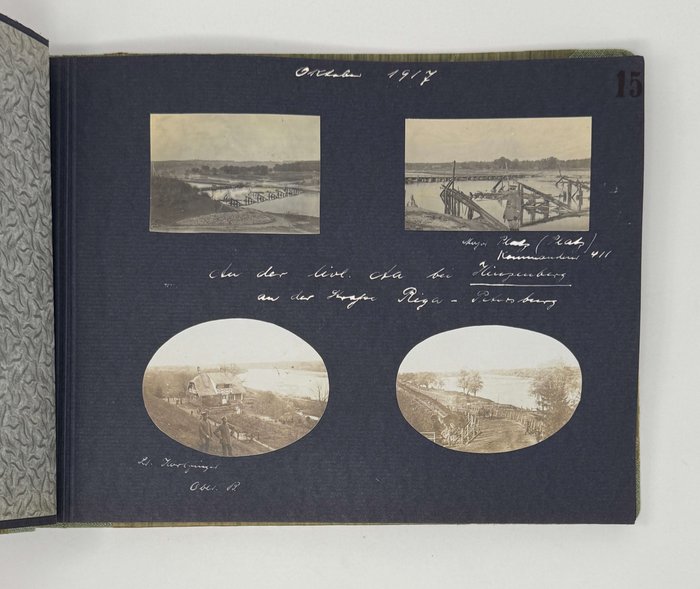

#PE38
Ca. October 1914 – August 1918
Six Oblong Folio albums: the first is ca. 22x31,5 cm (8 ½ x 12 ¼ in); the rest are ca. 25x34,5 cm (9 ¾ x 13 ½ in). 24, 20, 18, 18, 23, 21 [=124] card stock leaves with tissue guards and ink-stamped numbers on recto and verso. With 163, 160, 134, 117, 139, 145 [=858] mounted original gelatin silver photos, from ca. 12x16,5 cm (4 ¾ x 6 ½ in) to ca. 4x4,5 cm (1 ½ x 1 ¾ in); most images are ca. 8x10,5 cm (3 x 4 ¼ in) or slightly larger/smaller. All but a few photos with period white ink manuscript captions on the mounts (some captions relate to groups of photos); many are also dated in white ink; several images are captioned in negative. The first album with five mounted original drawings (four pencil and one watercolour) from ca. 9x14 cm (3 ½ x 5 ½ in) to ca. 7x12 cm (2 ½ x 4 ¾ in). Six period light green quarter cloth albums with papered boards; each album with black ink manuscript titles, dates and numbers on the front board. Bindings slightly rubbed on extremities, leaves of album No. 5 detached from the stub and loosely inserted (all present), several tissue guards with mild creases, several mounts with splits at the stub, a few photos mildly faded, but overall a very good collection of strong interesting photos.
Historically significant extensive collection of over 850 original gelatin silver photos, documenting the WW1 service of a young German officer, with over 620 vivid images of the events on the Eastern Front in 1915-1917, showing German advance to Poland (Tomaszow, Babiec, Bzura River) and Courland Governorate of the Russian Empire (modern-day southern Latvia), German positions and front line near Schmarden (Smarde) and Mitau (Jelgava) and the capture of Riga (September 1917). Ca. 140 images show people and events on the Western Front – trench warfare in northern France (Liancourt, Parvillers, La Chavatte) in October-November of 1914, after the Battle of Marne; and military actions in Alzase-Lorraine (Cutting, Vic-sur-Seille, Bitche) and northern France (Noyon) in December 1917 – August 1918. The albums belonged to a young German officer, who, for the first half of the war (October 1914 – November 1916), served in the 4th Company of the 28th Landwehr Infantry Regiment of the German Imperial Army and in December 1916 – August 1918 (the end of the last album) – in the 411th Infantry Regiment.
The first album (October 1914 – June 1915) opens with over 50 photos of military actions in northern France in October-November 1914, mostly in and near Liancourt (Oise department), showing officers and soldiers of the compiler’s 4th company (with many names captioned), artillery guns, field kitchens, Liancourt (streets, the compiler’s quarters, local “schloss”), French civilians, schützengraben (trenches) near Liancourt and in Parvillers and La Chavatte (west of Amiens), &c.
The rest of the album (over 100 photos) documents Germany’s advance to Poland in the spring of 1915. The images show the compiler’s travel to western and then central Poland and service in the German military camp in Heinrichswalde near Boguslawke (April–May 1915) and in Babiec and near the Bzura River (May-June 1915). The images include views of a military train and the troops’ arrival to Tomaszow, Polish villages and peasants, German camps in Heinrichswalde, near Babiec and Bzura River, trenches (completed and under construction), the interior of German dugout shelters with log furniture, individual and group portraits of the regiment’s officers and soldiers (attending a Christian service in a makeship chapel, having meals, swimming, posing next to their quarters), view of Babiec, &c.
The album also contains four pencil drawings, showing the compiler in his dugout shelter near the French village of Thiepval (Somme department), German log shelters in Heinrichswalde and near Bzura River, and the grave of officers [Stellverts?] and Mausolf near Heinrichswalde. The watercolour drawing shows a “Russian observation post” on the bank of the Bzura River.
The second album (summer 1915 – January 1916) starts with over 70 photos of Germany, apparently taken during the compiler’s sick leave, showing the Evangelical hospital on Fürstenwall Street in Düsseldorf (hospital façade, rooms, nurses, Düsseldorf streets and sites), the compiler in civil suit and military uniform, his family, vacation in Kettwig and Blankenburg, &c. The rest of the album (over 80 images, dated November 1915 - January 1916) is centred around the military actions near the village of Schmarden in Courland (Smarde, Latvia, west of Riga), which was captured in the course of the German advance to the territory of the Russian Empire in the summer of 1915. The photos show the ruins of the railway station and damaged railway tracks, an exploded railway bridge, hidden observation posts on forest trees, an armed rail track trolley, dogs pulling a cart with a machine gun, a moose hunted by Germans, horse stables, a field kitchen with the regiment’s number, building of fortifications, concealed artillery guns, officers’ quarters, Germans celebrating Christmas. There are also several group portraits of local women or families.
The third album, with over 130 photos, documents military actions in Courland from January to April 1916. The photos show the winter construction of fortifications near Schmarden, completed trenches, a wardrobe used as a sentry box, the altar of a military chapel, the company’s review, military exercises, an aerial photo of trenches and fortifications, Lunin village, Tuckum/Tukums (St. Nicholas Russian Orthodox Church, Lutheran church, market square, streets, war destruction), Mitau/Jelgava (Mitau Palace and park, Lielupe River waterfront, St. Simeon and St. Anna’s Russian Orthodox Cathedral, city bridges, ruined factory, German officers with local noble women), fortifications at the shore of the Baltic Sea (Gulf of Riga), a field hospital, a military cemetery, portraits of German officers and soldiers (celebrating Christmas and New Year, Kaiser’s birthday, wearing white snow suits, showing their medals, posing with a “90-year old woman,” playing a snowball fight, standing with a bicycle), Russian prisoners-of-war, &c.
The fourth album (May – winter 1916, ca. 117 images) opens with three larger photos documenting German Emperor Wilhelm II’s visit to Mitau on May 28, 1916 (troop review). The other images (all but a dozen taken in Courland) show trenches and fortifications, border markers “between Courland and Livland,” Mitau (ruined houses), Libau/Liepaja (harbour with torpedo boats, city streets, Russian church, Baltic Sea coast), military graves, hand grenades, artillery positions, German telephone tower concealed between forest trees (exterior and interior), the compiler’s quarter with vegetable garden at the front, a wrecked train on a bridge, “a typical country house,” portraits of German officers and soldiers (wearing gas masks, posing with musical instruments, field post parcels, ploughing a field, playing sports, praying during an outdoor church service), Latvian peasants, families, &c. There are also several photos from a concert of the regiment’s music band in Poland (June 1916) and portraits of the compiler and his wife during their honeymoon.
The fifth (December 1916 – July 1917) and sixth (August 1917 – August 1918) albums document the compiler’s service with the 411th Infantry Regiment of the German Imperial Army. The entire fifth album (ca. 130 images) and over 50 photos in the sixth album continue to depict the events in Courland. A series of photos of a German “Waldlager” (forest camp) in Buschhof (apparently near Jacobstadt/Jekabpils) show main structures and dwellings, information signs, German military men. Another group of photos show a military camp and frontline near Nordeck/Nordeki (dwellings, soldiers’ mess, the interior of officers’ casino, a view towards Russian positions, bodies of Russian soldiers, cases of Russian shells); 411th positions in Schmarden, &c. There are also portraits of German staff officers, military men swimming in the Gulf of Riga, a Russian prisoner-of-war, several family portraits, &c. Over 50 photos in the sixth album, dated August-October 1917, document the German advance and the fall of Riga (September 1917). Interesting images show captured Russian positions, Riga’s suburb and resort Kemmern/Kemeri (ruined villages, Russian chapel, Russian military cemetery), Hinzenberg/Incukalns village east of Riga (villas, ruins, German positions near the Livonian Aa/Gauja River, military review with Prince Leopold of Bavaria), &c.
Over 80 photos (December 1917 – August 1918) illustrate the compiler’s service in France. A series of photos were taken in Alsace-Lorraine (Küttingen/Cutting, Wich/Vic-sur-Seille, and Bitsch/Bitche; all in the modern-day Moselle department, Grand Est region of France). The images include city and street views, portraits of German military men and local civilians, Prince Oscar of Prussia inspecting weapons in a forest near Bitsch, an artillery unit at work, a distant explosion, &c. The last group of photos shows the military actions around Noyon (Oise department), a sports competition for German soldiers, a hospital for convalescent officers on the border between France and Belgium, &s. The last photo is a large group portrait of captive German officers in Albertville (southeastern France).
Overall, an important extensive original source on the history of German military actions in Latvia, Poland and France during WW1.


